Everyone has noticed the importance of set-pieces in this Premier League season and how many matches they have decided, so you will not be surprised to know that many teams like Arsenal, Newcastle United, Liverpool and Tottenham have invested in set-piece analysis by adding set-piece analysts to their backroom staff.
The corner kick is one of the most common types of set-pieces, so we will explain this mysterious part of football analysis and how teams exploit it depending on the defensive system of the opponent.
There are three types of defensive systems at corners: man-marking, zonal marking and hybrid. This tactical analysis will start by dissecting the man-marking defending system and understanding its disadvantages.
The most significant disadvantage of the man-marking defending system in corners is that the opponents can control the movement of the defending team’s players by dragging them wherever they want, so attacking teams use this disadvantage to design their corner routines.
Depending on the previous disadvantage, attacking teams have three general ideas with different tactics to design their corner routines: dismarking using blocks and screens, exploiting free players standing in the rebound zone and positional superiority using one of these two principles that we will explain: mismatch and orientation.
Dismarking (using screens and blocks)
In this case, using an example from Fulham versus Aston Villa from 20th October 2022, we see how Aleksandar Mitrović almost scored a goal from a corner only for the defender to strike the ball at the last moment.
Let’s start with how Aston Villa set up to defend the corner. As shown below, they defended with two zonal markers highlighted in green, six man-markers, while Ashley Young, who stands on the edge of the six-yard box, had instructions to go forward to guard against a short corner, if played, along with Leon Bailey highlighted in yellow to be in a 2v2.
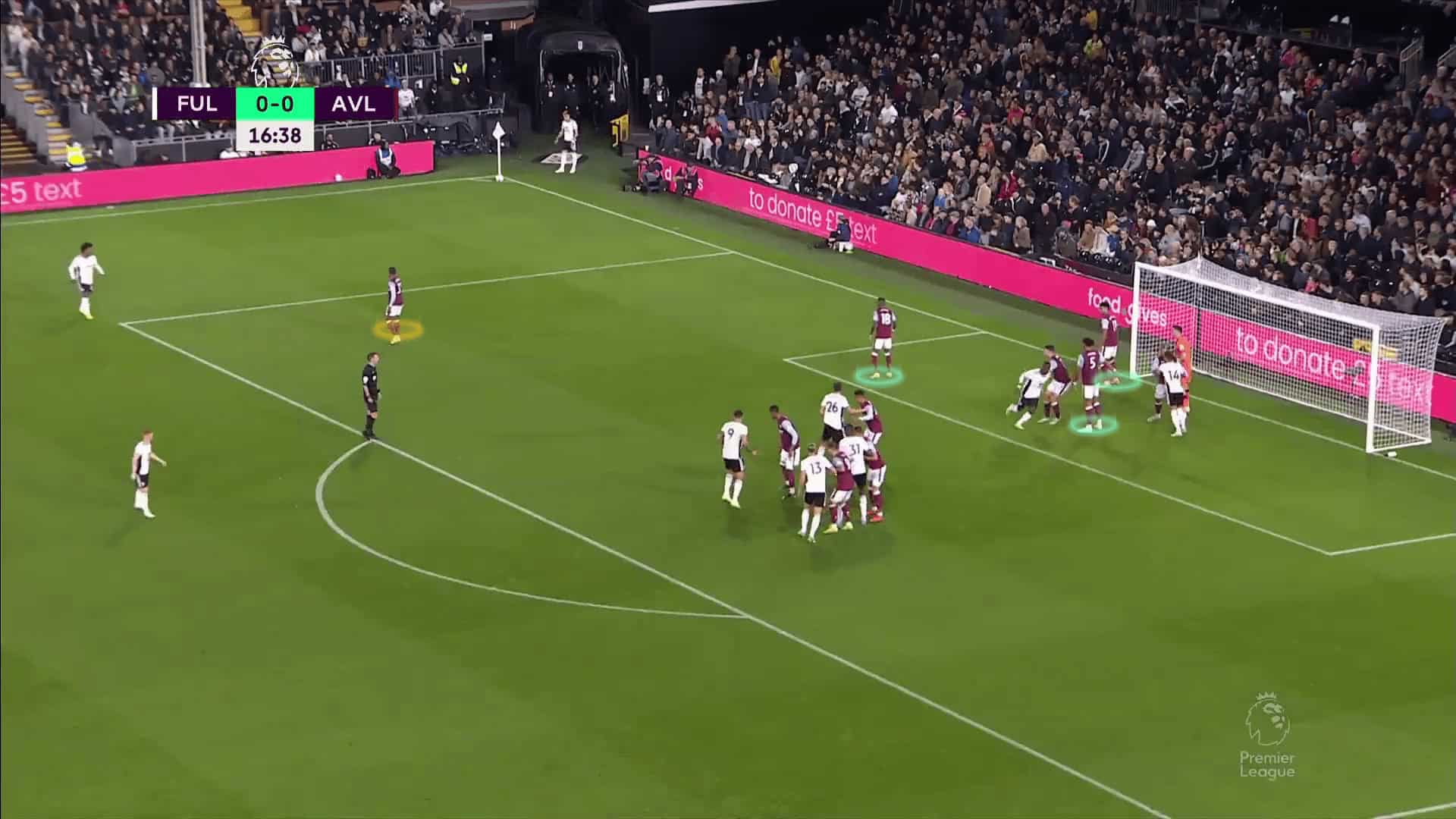
Fulham have placed two players inside the six-yard box, four players in a pack — which helps some of them to act as screens — and three players in the rebound zone. When the taker starts moving, Mitrović goes to the far post via a curved run. Meanwhile, João Palhinha (at the front of the pack with a yellow arrow), goes to the near post dragging his marker with him and the remaining two of the pack act as a screen to help Mitrović escape from his man-marker.
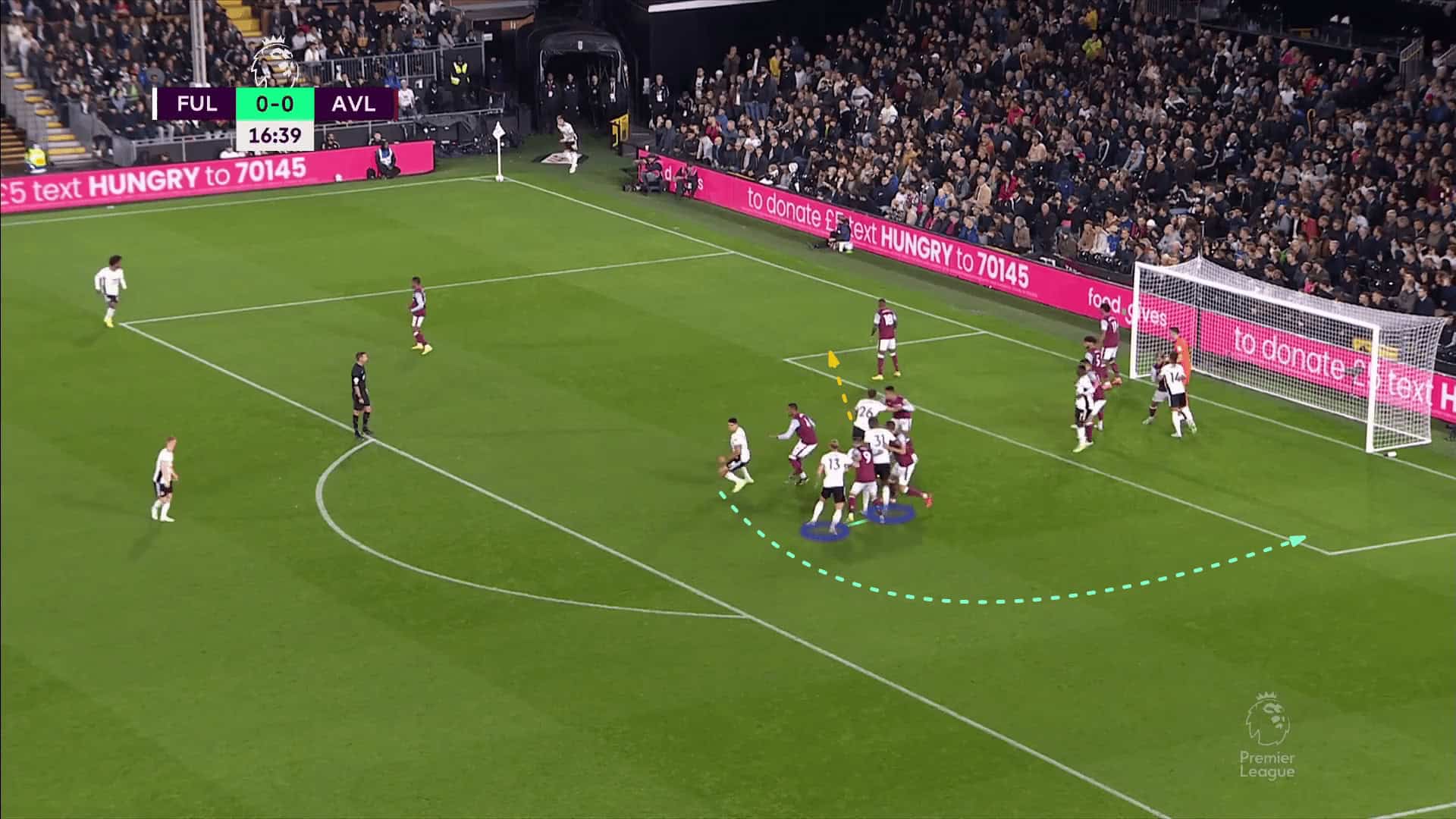
In the first photo, the player highlighted in yellow blocks his marker to prevent him from going to the far post to make the targeted area empty for Mitrović, the two players highlighted in green act as a screen and the player with a blue arrow goes to block Mitrović’s marker in case he escaped from the first screen as shown in the second photo. Then, Mitrović headed the ball but Aston Villa’s defender cleared it at the last moment.
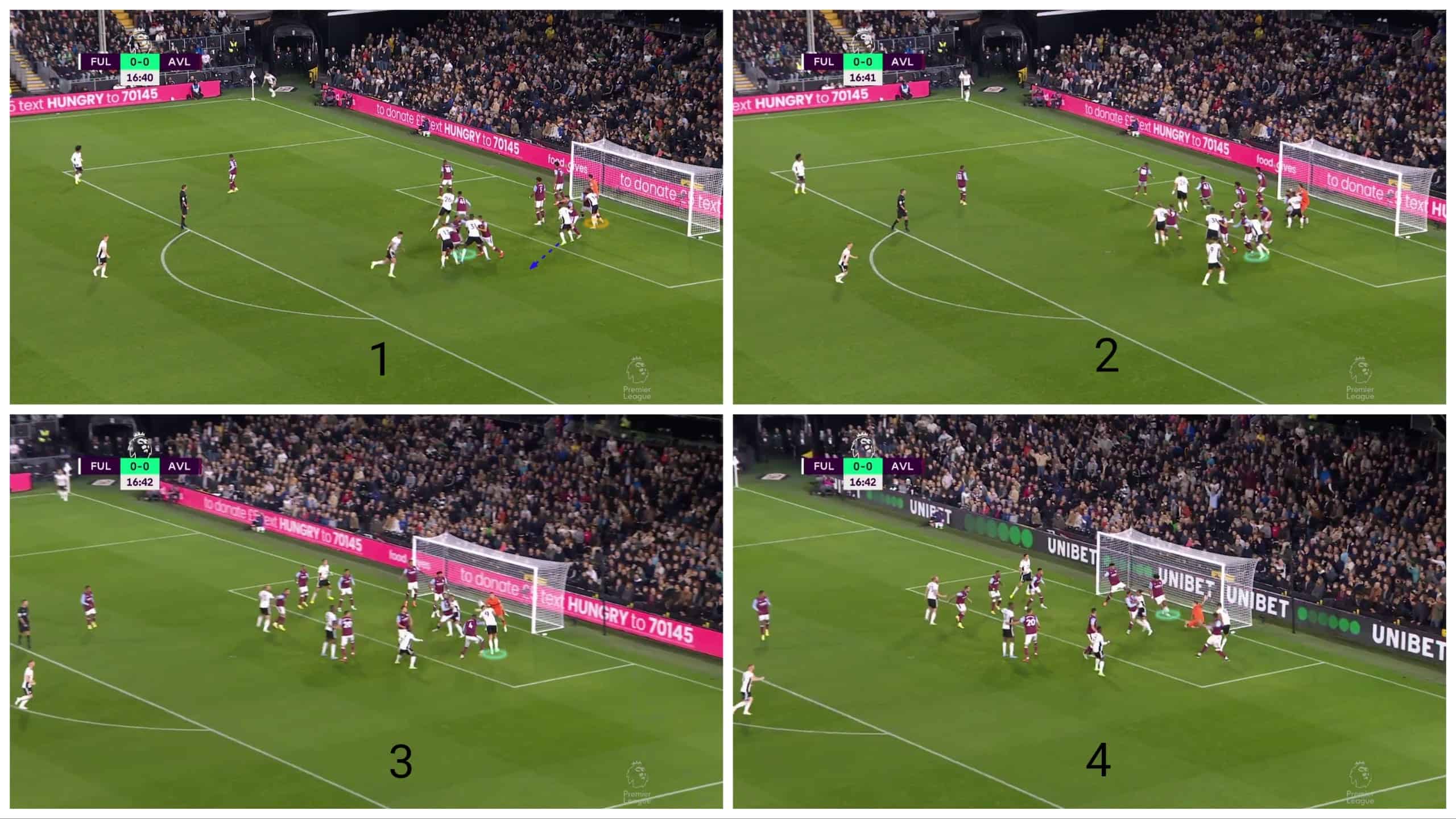
Toison Adarabioyo scored an important goal for The Cottagers against Nottingham Forest in the City Ground back on the 16th of September. Here, we can clearly see that Nottingham Forest were defending with two zonal markers highlighted in green and six man-markers.
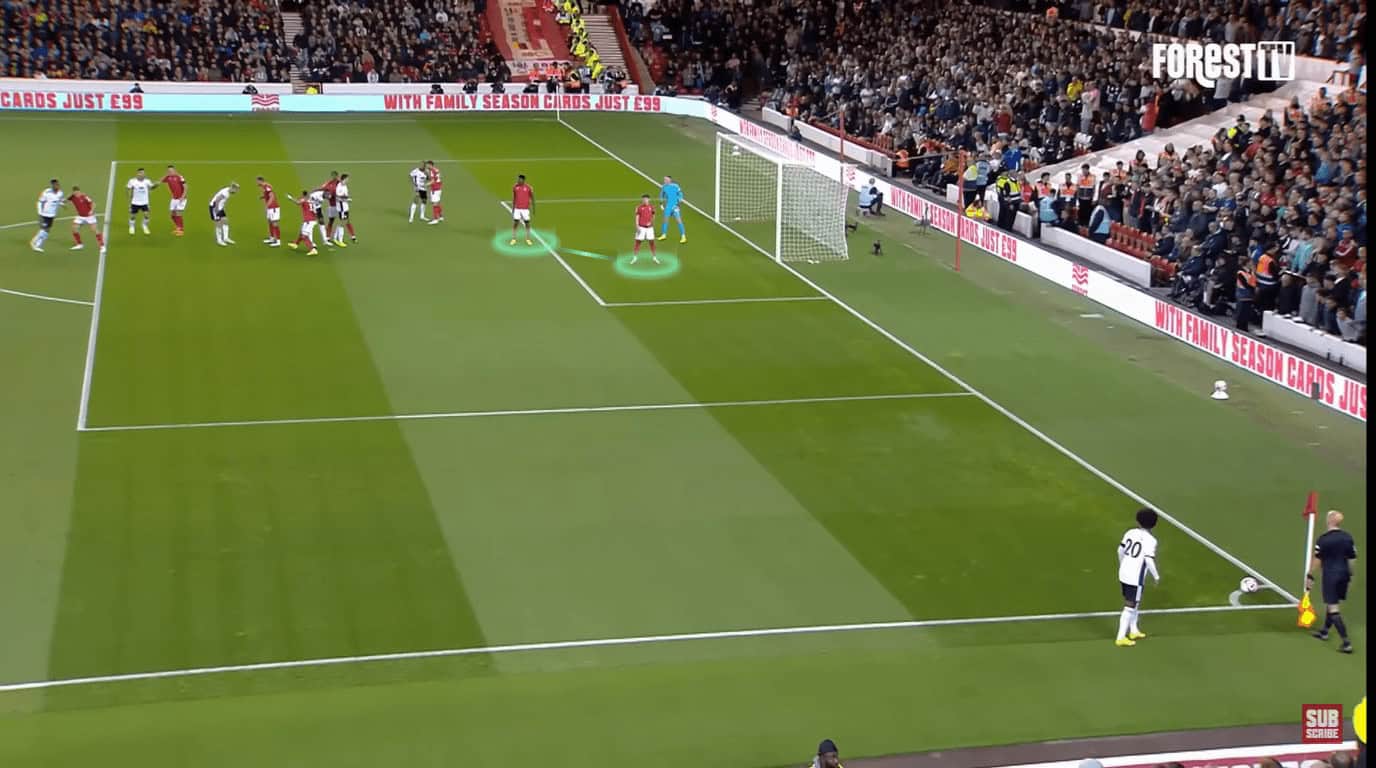
Meanwhile, moving on to the next image, we see the player in yellow standing on the edge of the box in case he has a chance to contest the second ball as the player highlighted in green stays deeper, mainly in preparation for the potential counterattack.
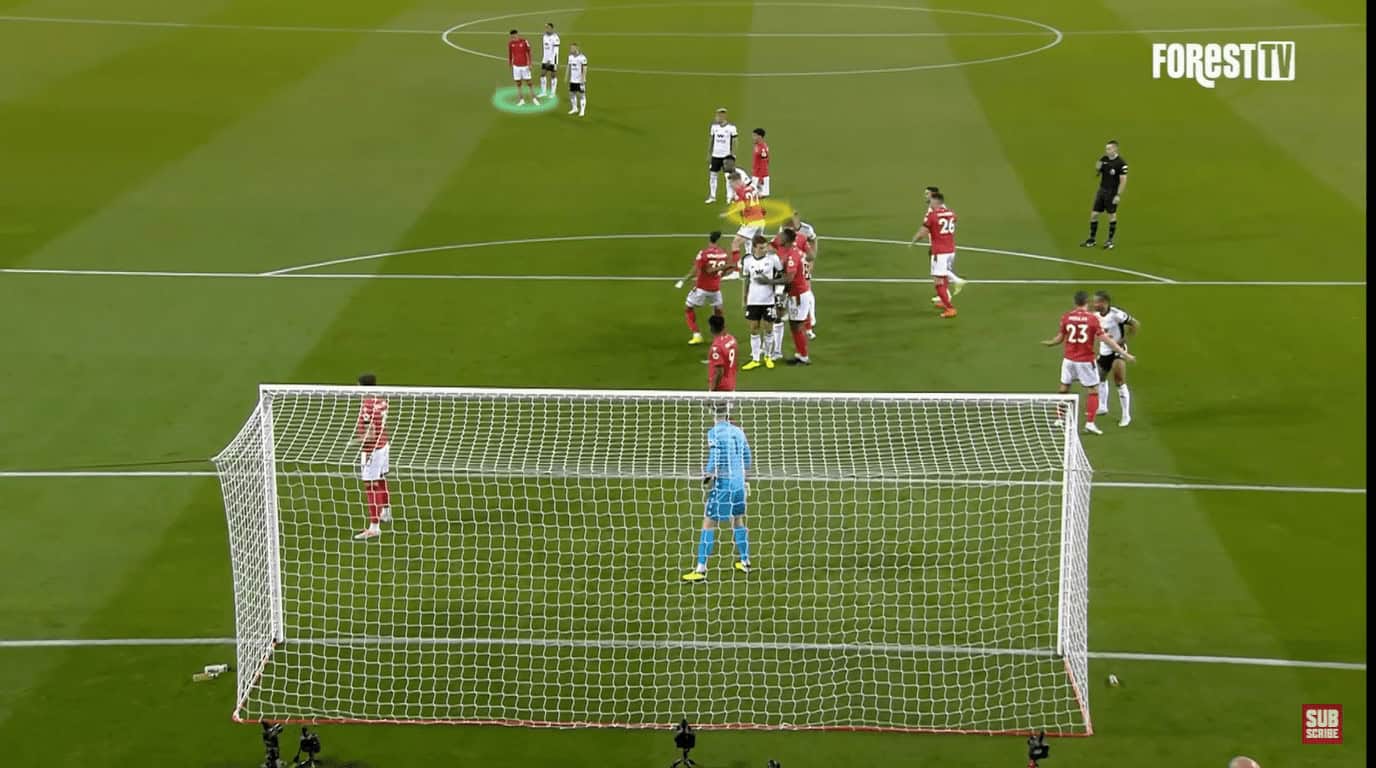
In the first photo below, when Willian starts moving, Mitrović (yellow arrow) moves to act as a screen. This helps Tosin Adarabioyo (green arrow) escape from his marker — an action that had been completed by the second photo.
At the same time, in the third photo, we see how everyone has a role to perform as the routine begins. The player positioned furthest from the kick-taker, marked with the yellow arrow, goes to the far post whilst two players with green arrows make their runs towards the near post — dragging their man-markers to make the middle space empty.
We see the result of this in the fourth picture, where the targeted zone is in black with a block highlighted in green.
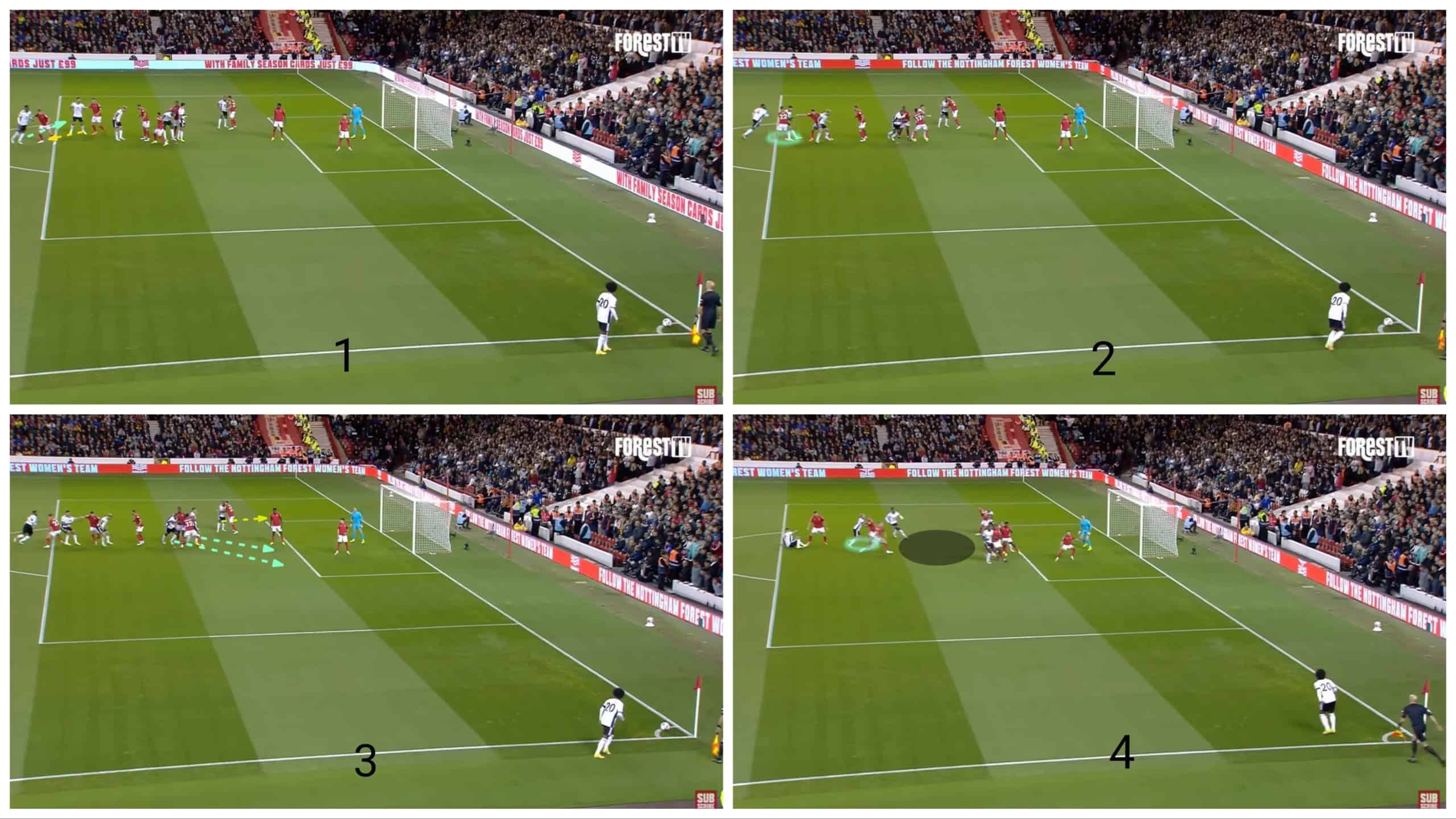
After all of this, the targeted zone is empty for the player highlighted in green to invade and pounce as the well-delivered ball drops. The result is a goal.
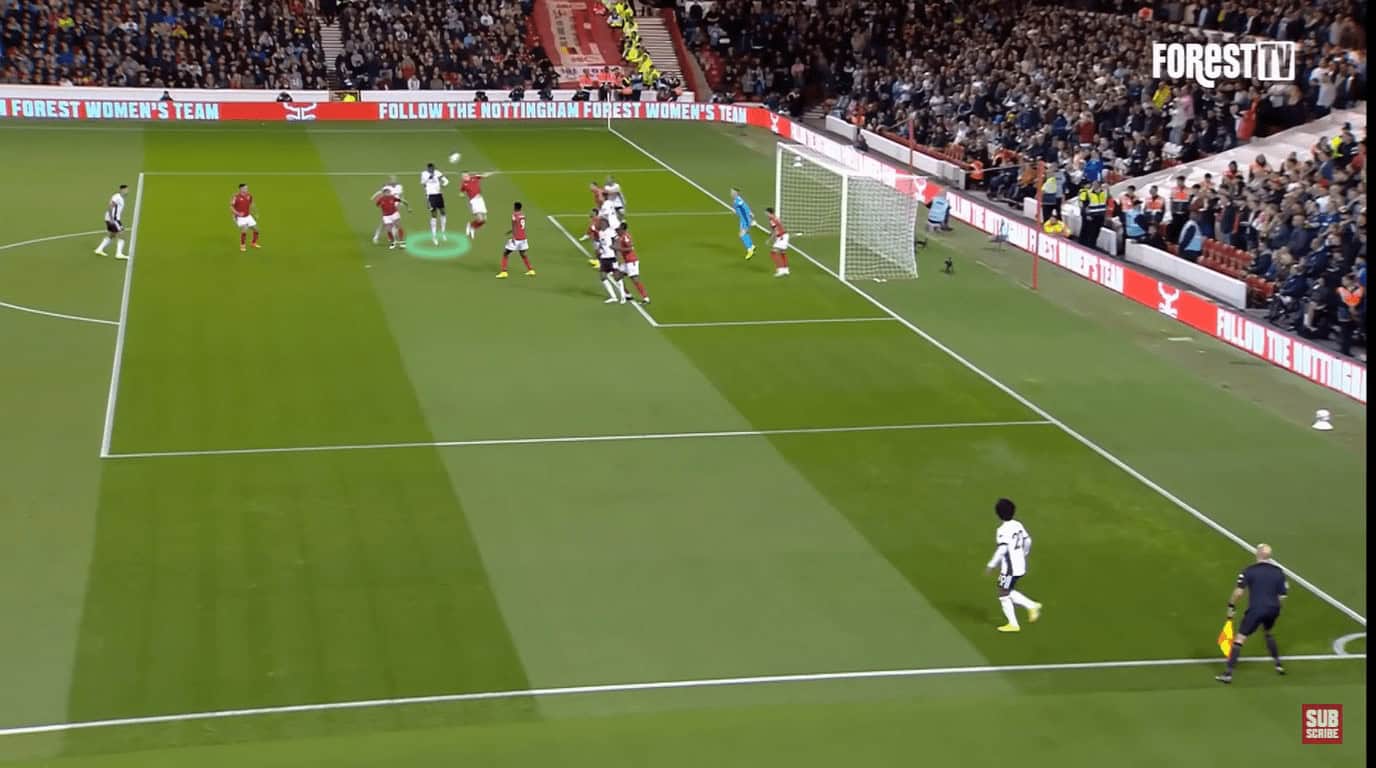
Exploiting free players standing in the rebound zone
As we said, the biggest problem in the man-marking defending system is that the defender follows his marker without thinking, so let’s count players to get the idea. In this same 20th October game versus Aston Villa, The Villans defended with two zonal markers inside the six-yard box (highlighted in green) and one zonal marker (in yellow) with a different role to go forward to defend the short corner, with the player standing on the edge of the box and the six remaining players acting as man-markers.
The problem with this becomes evident when Fulham decide to attack with six players inside the box to drag six players from Villa, making the rebound zone empty.
Here, Fulham performed another trick — Neeskens Kebano, on the edge of the box and highlighted with the blue arrow here, is initially positioned in the rebound zone to drag his marker, making sure that this area is empty.
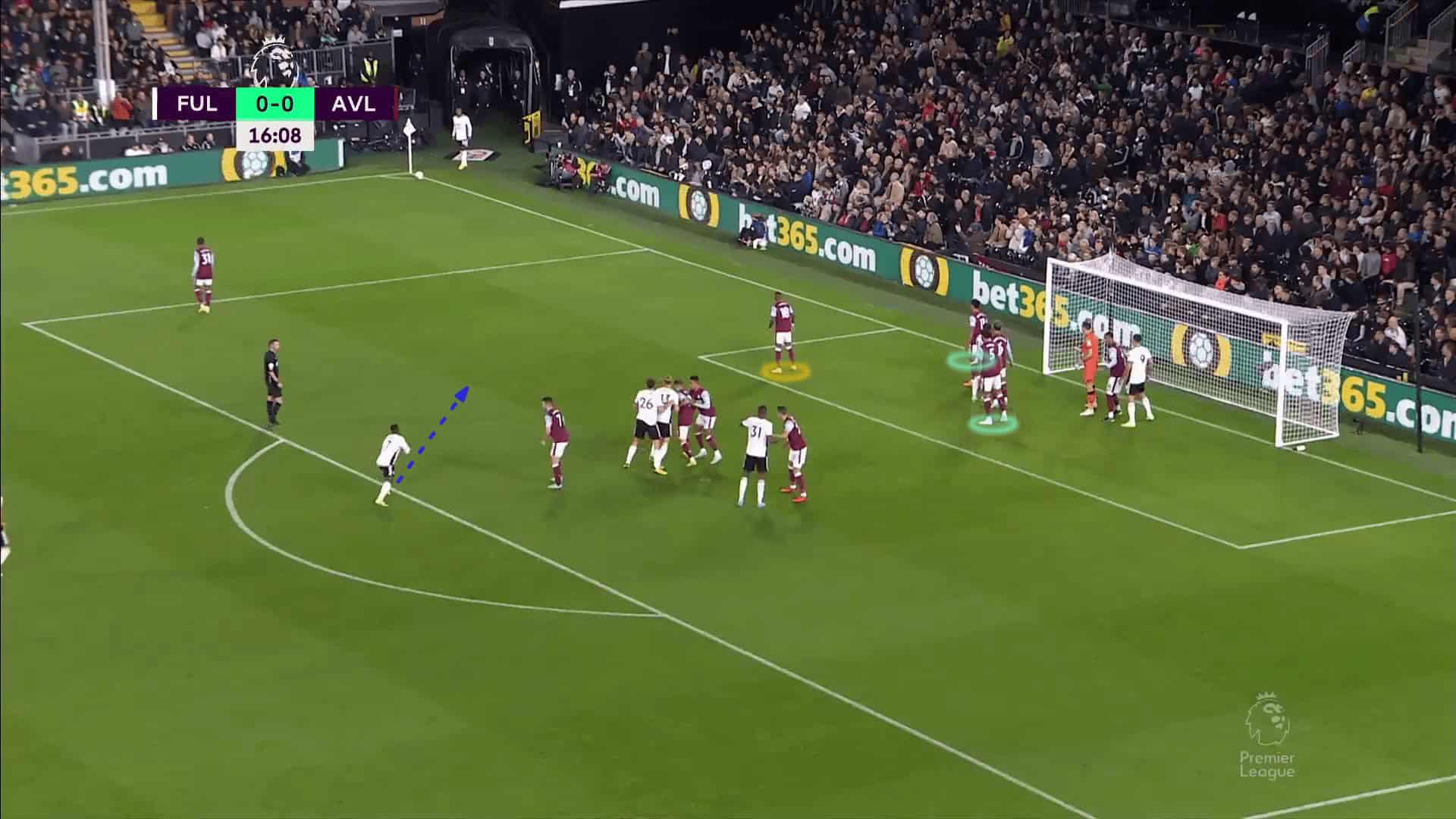
When the taker starts moving, two players with yellow arrows run toward the near post, dragging their markers away from the goal and three players move inside blocking their markers, so the rebound zone is empty for the player who comes from the back.
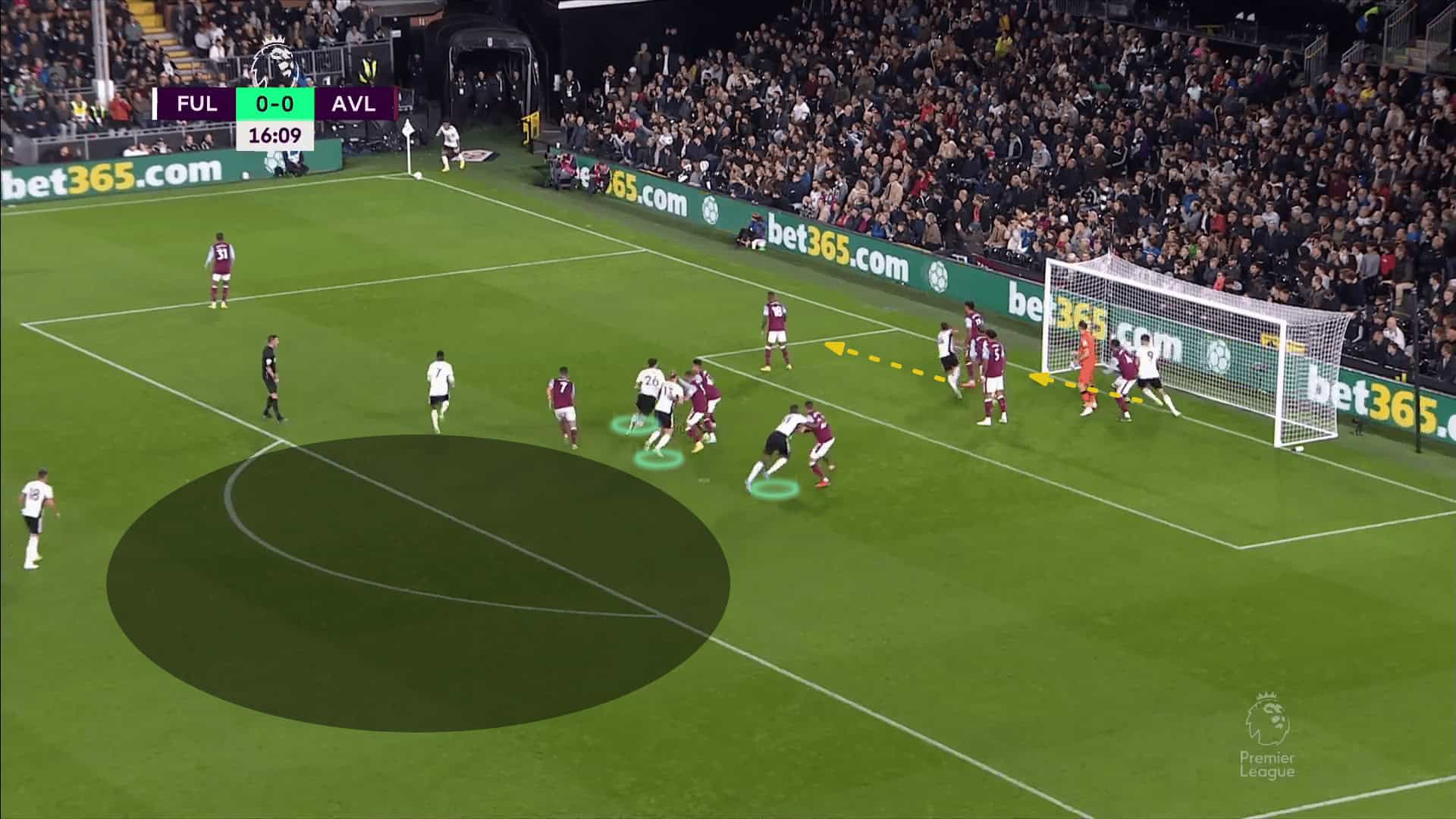
Another thing to note is that zonal defender Tyrone Mings, highlighted in green, is the only one who has a way to reach the ball, but he is too far to really have the desired impact on the incoming cross. All of this results in a decent shooting opportunity for Fulham on the rebound as the ball falls to the man on the edge of the area.
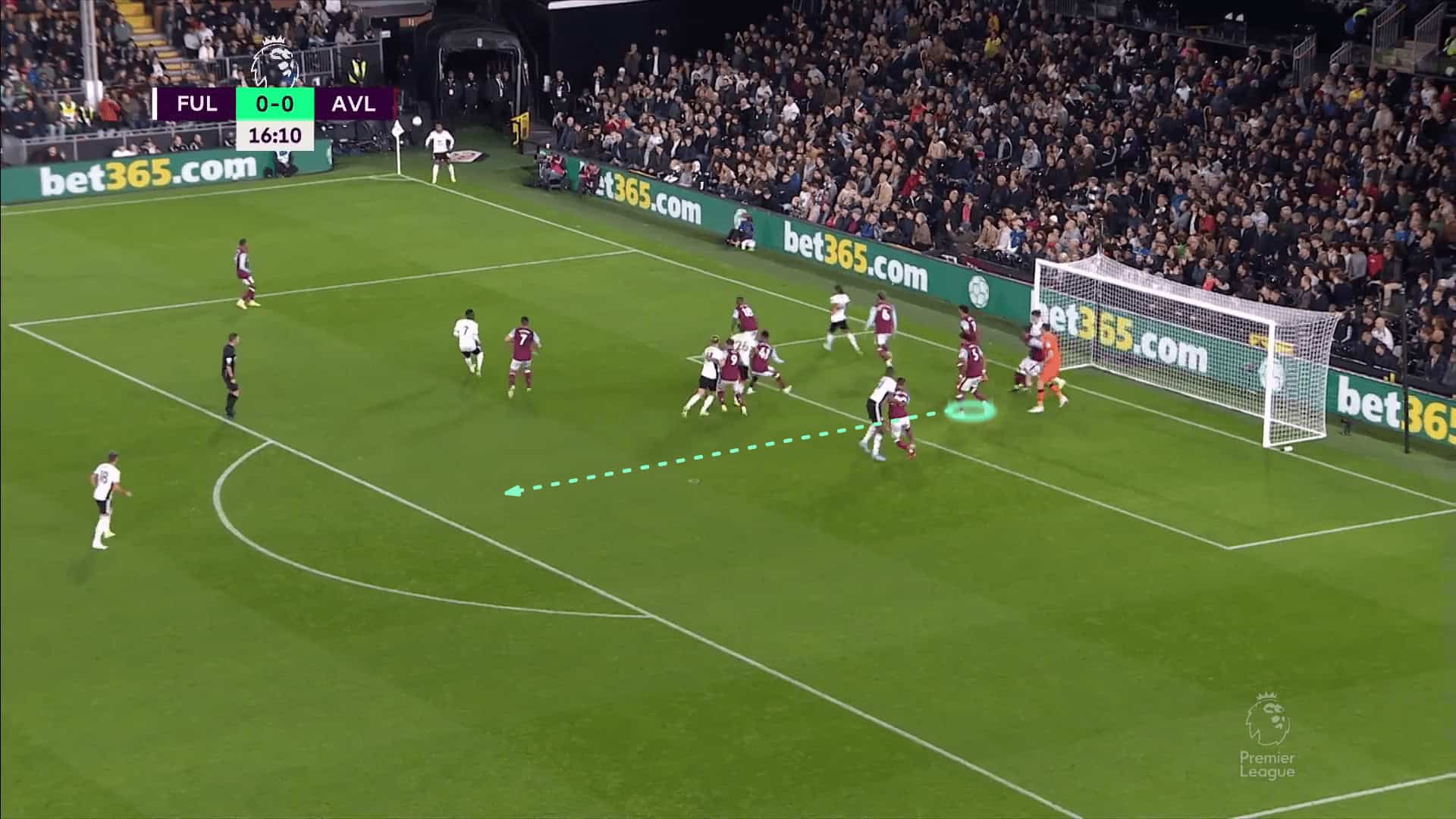
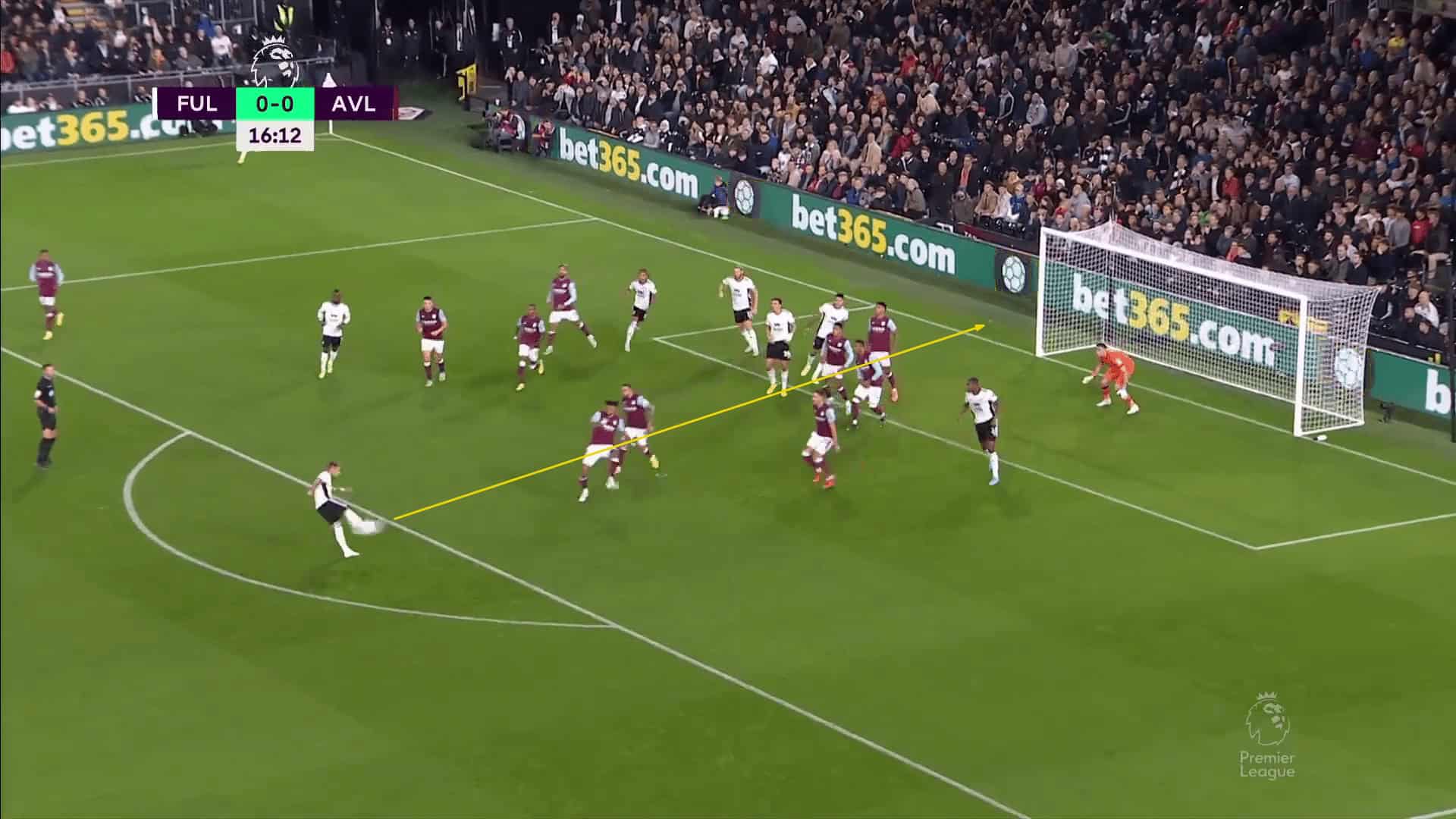
When Arsenal visited Villa Park in February, Oleksandr Zinchenko scored an amazing goal using an idea similar to Fulham’s against Villa in the previous corner. As was the case above, Villa defended with two zonal players in the six-yard box, one zonal player with duties to support Philippe Coutinho in a 1v2 situation against Bukayo Saka and Martin Ødegaard, and six man-markers.
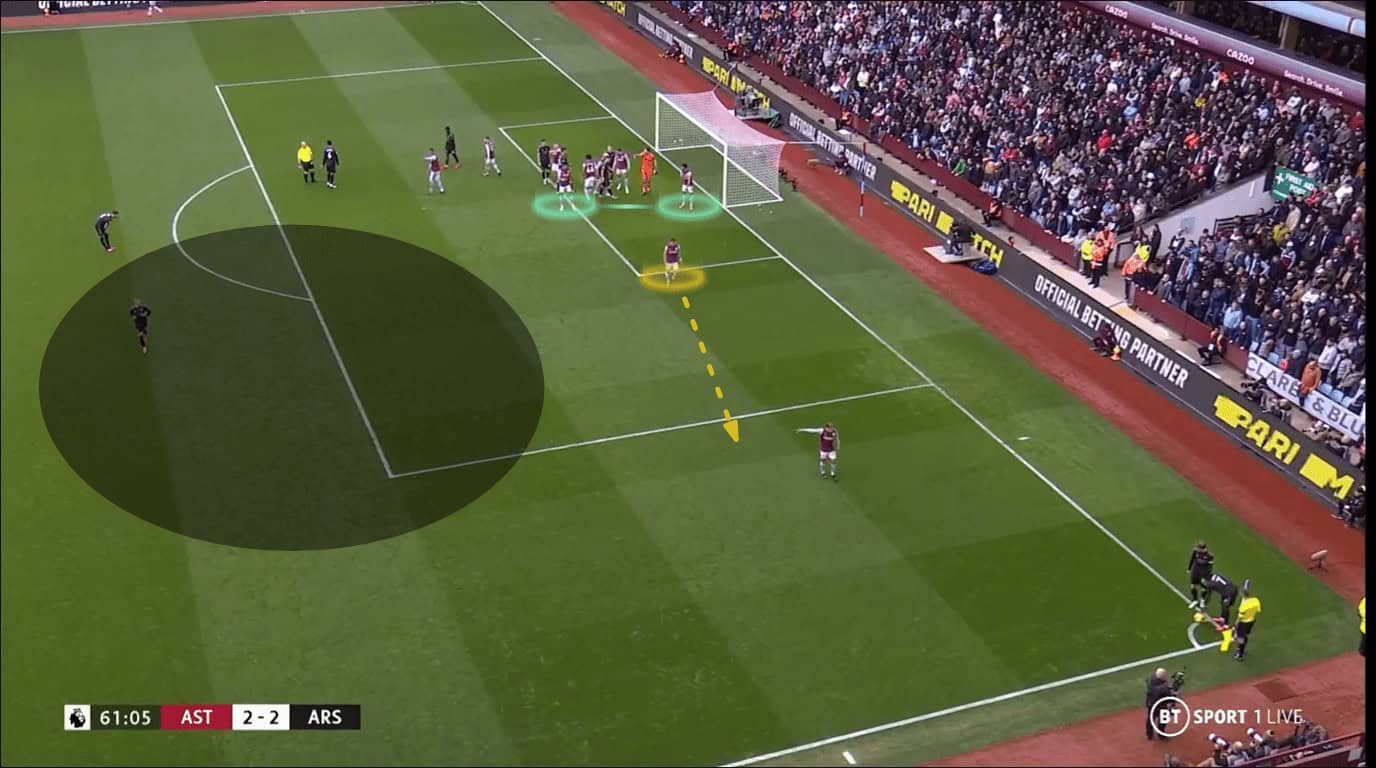
Here, Gabriel Magalhães and Eddie Nketiah play an important role which is called ‘misdirection’ because they provide the greatest aerial threat in Arsenal’s team, which makes Villa’s defenders focus on the far post, making the right side of the goal more empty for Zinchenko’s strike.
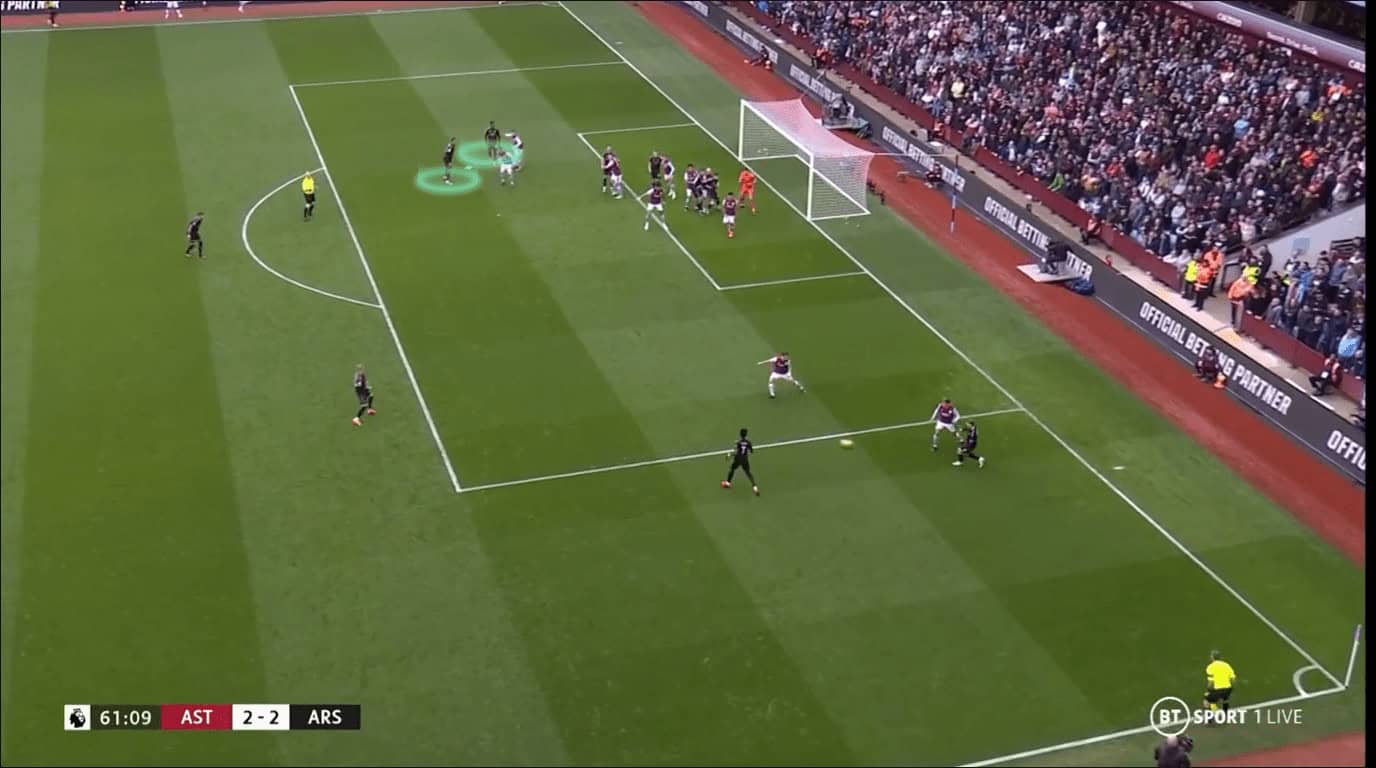
When the short corner is played, the player highlighted in green can’t leave Coutinho in a 1v2 situation and that makes the two yellow zonal players go to defend Zinchenko’s strike but it is too late to adequately deal with the danger.
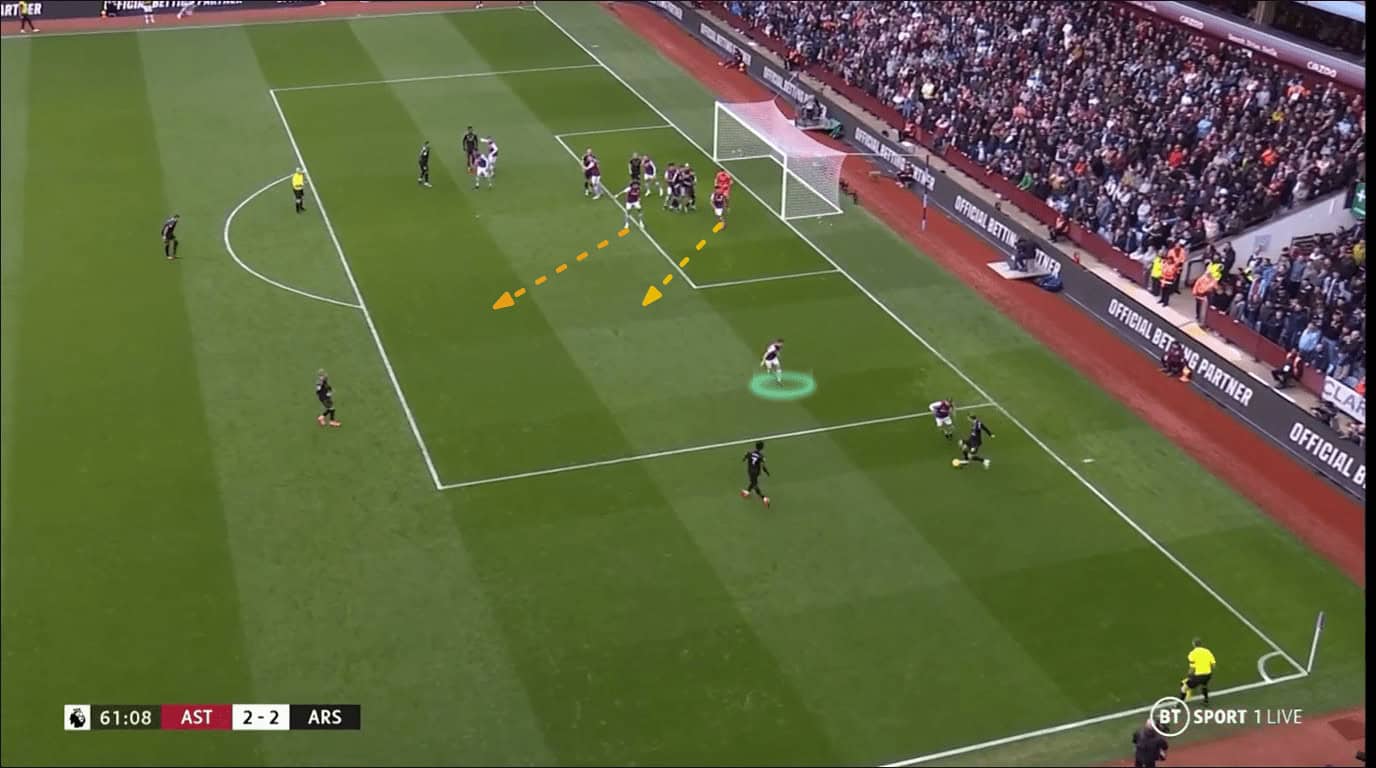
Another thing to note is the position of the three Arsenal players highlighted in green framing the goal in case the goalkeeper punches the ball out. This serves another purpose too, as it also blocks Villa’s defenders, preventing them from getting out to Zinchenko.
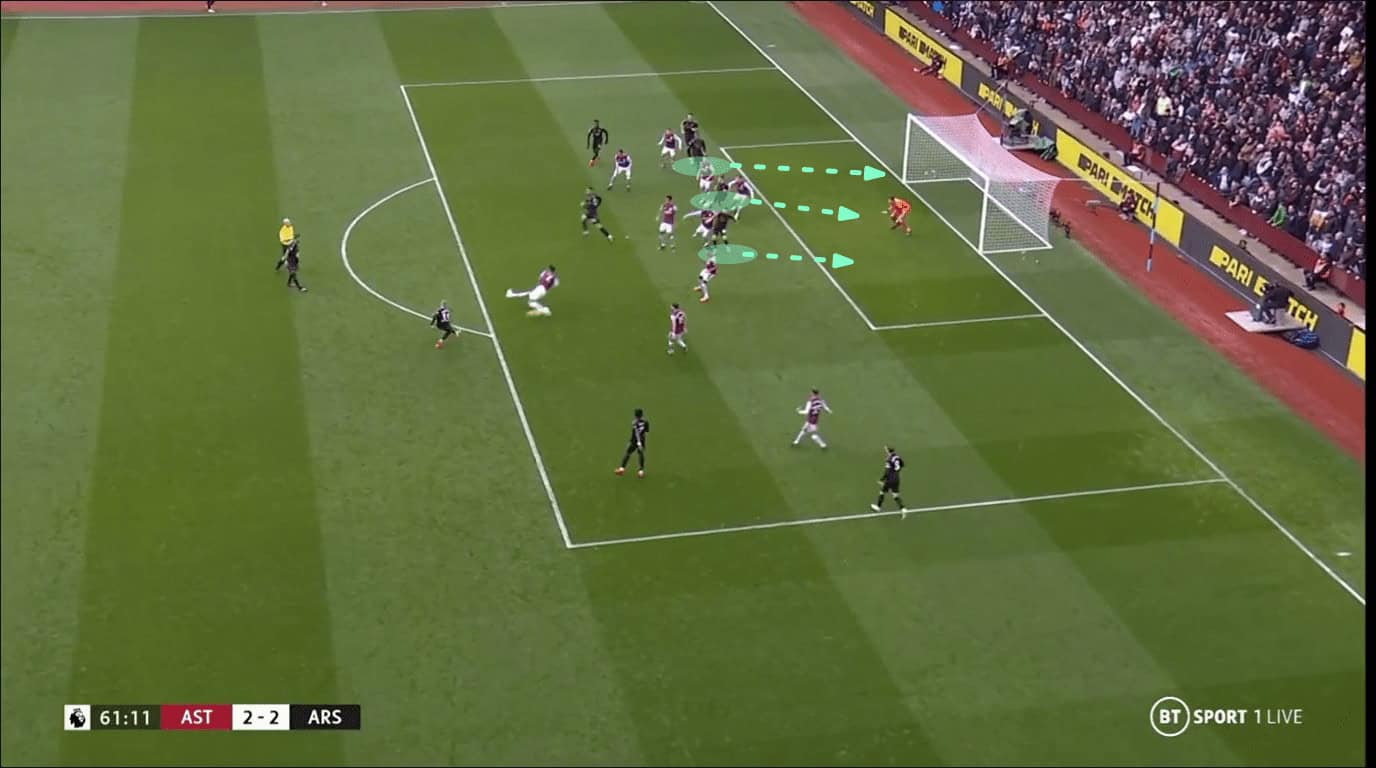
Gabriel Martinelli scored an important goal through a brilliant routine against Crystal Palace at Selhurst Park in the first match of this Premier League season. Here, Crystal Palace defend with two zonal markers in green, one player for the short option in black, one in yellow to defend the rebound zone and the remaining six players as man-markers.
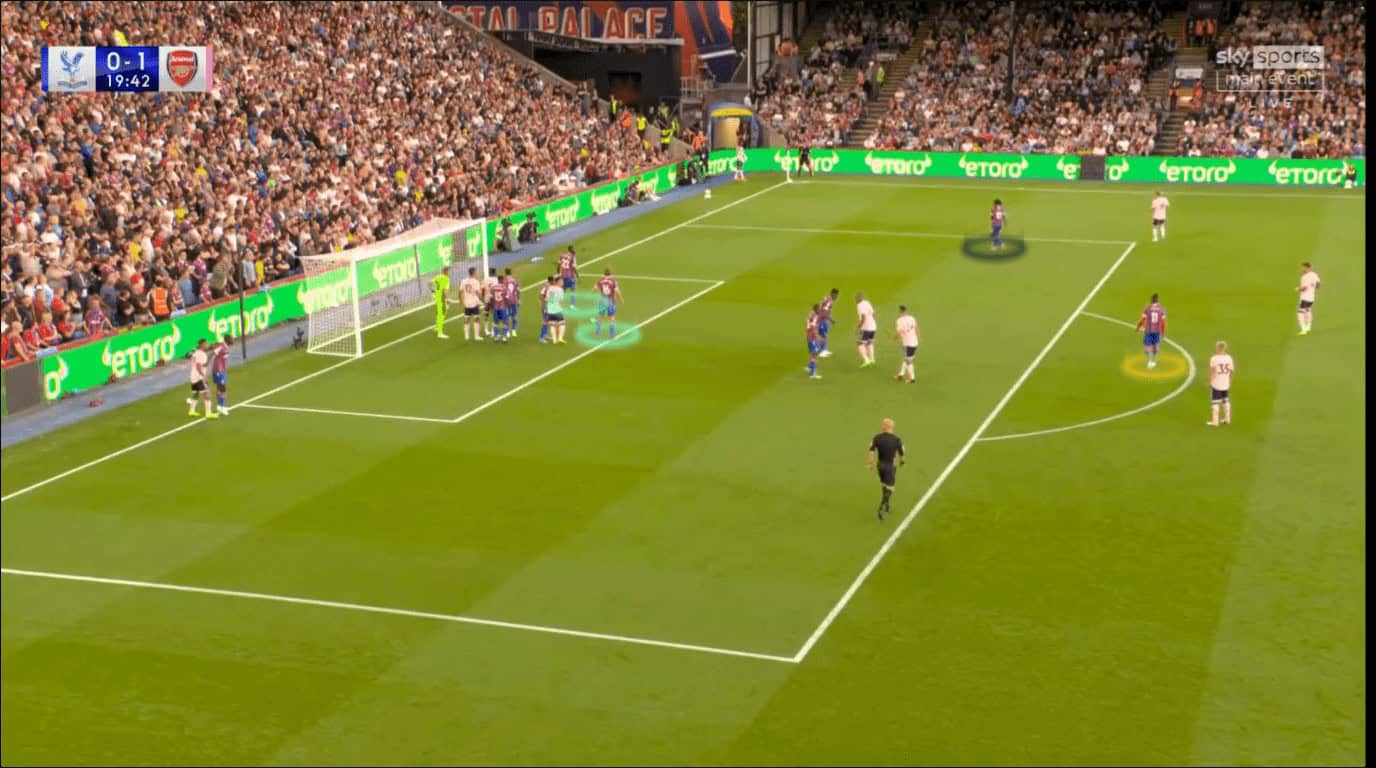
As Saka prepares to take the corner, Arsenal’s routine begins. As shown below with the green arrow, Zinchenko, who acted as a rebound zone player, gets into the box without any marker whilst Granit Xhaka stays back instead of him. Gabriel Jesus, highlighted in yellow, wants to fix his marker here out of the game to make the area empty for Zinchenko. Meanwhile, Gabriel, with the black arrow, goes to the far post to frame the goal and wait for Zinchenko’s headed pass.
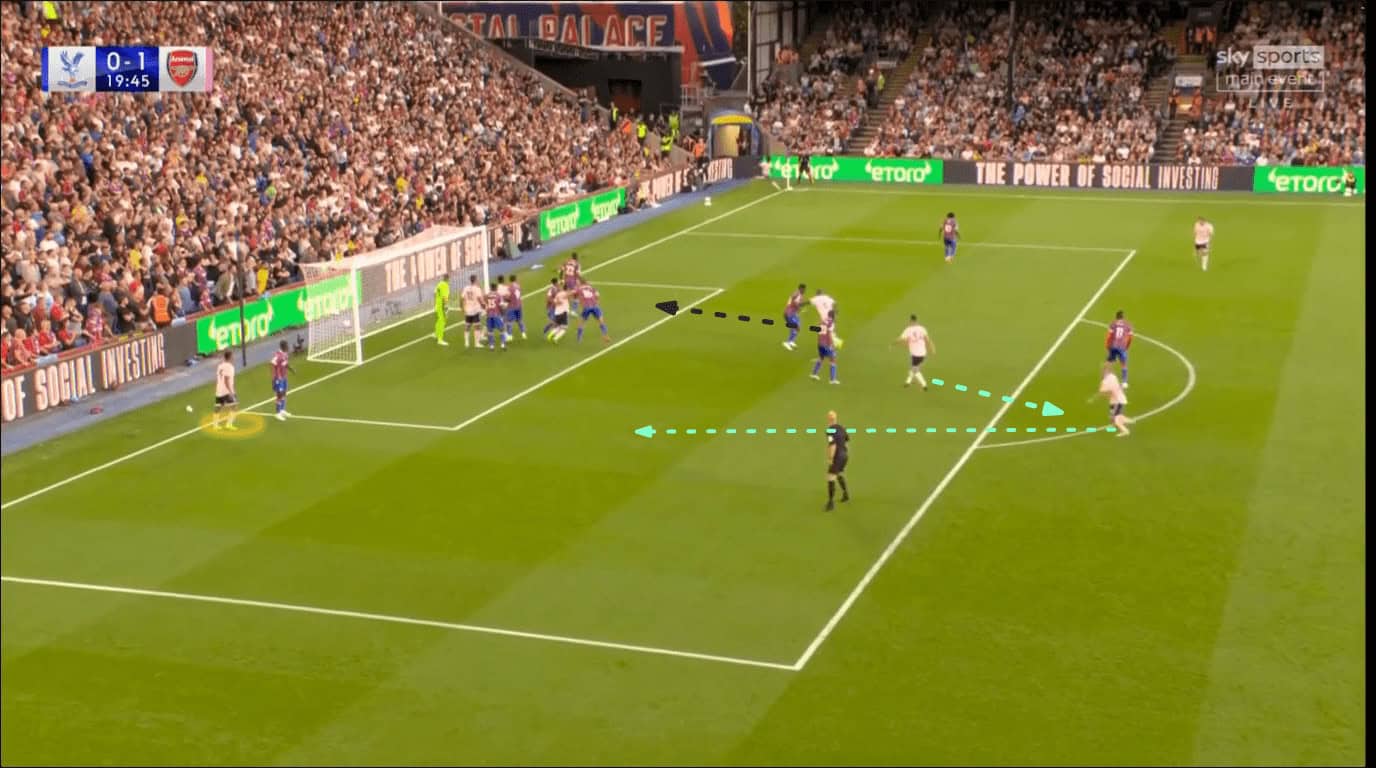
The important note here is the principle of orientation. This happens when the defender can’t see the ball and the opponent at the same time. In the first photo, when the ball is about to reach Zinchenko, every defender can easily see his marker, but in the second photo, Arsenal’s players move behind them using the orientation principle, so Martinelli who is highlighted in green can easily get the ball.
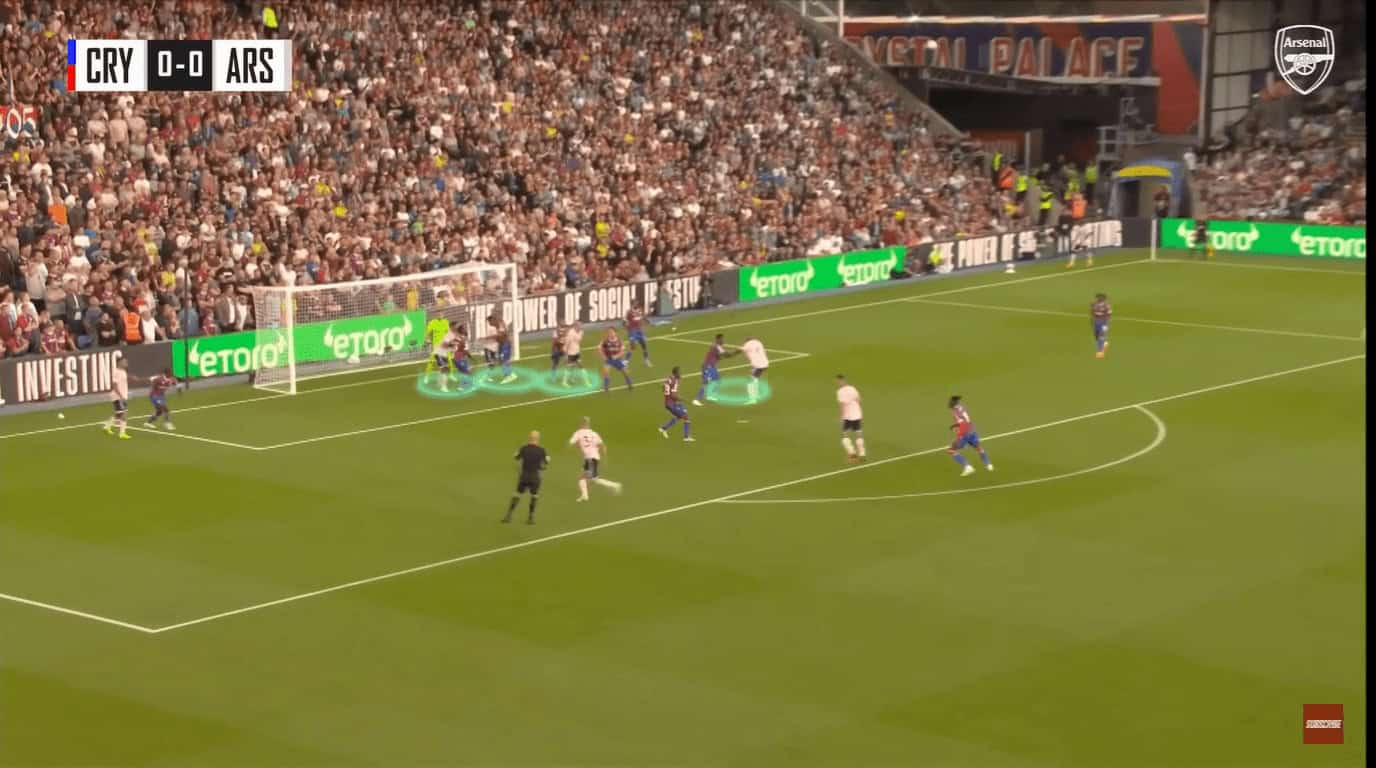
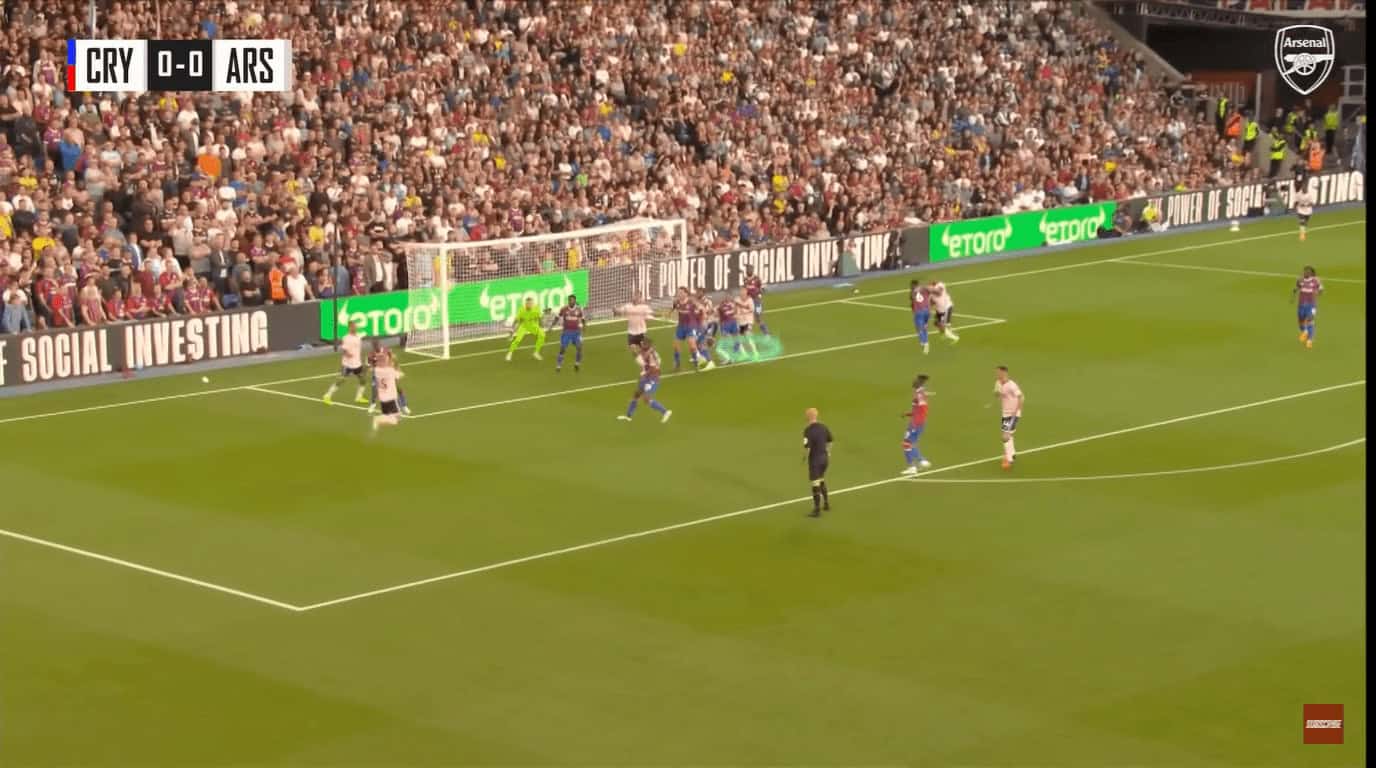
Zinchenko nods it into the six-yard box, where three of Arsenal’s players frame the goal and Gabriel is behind them. Martinelli meets the ball and scores.
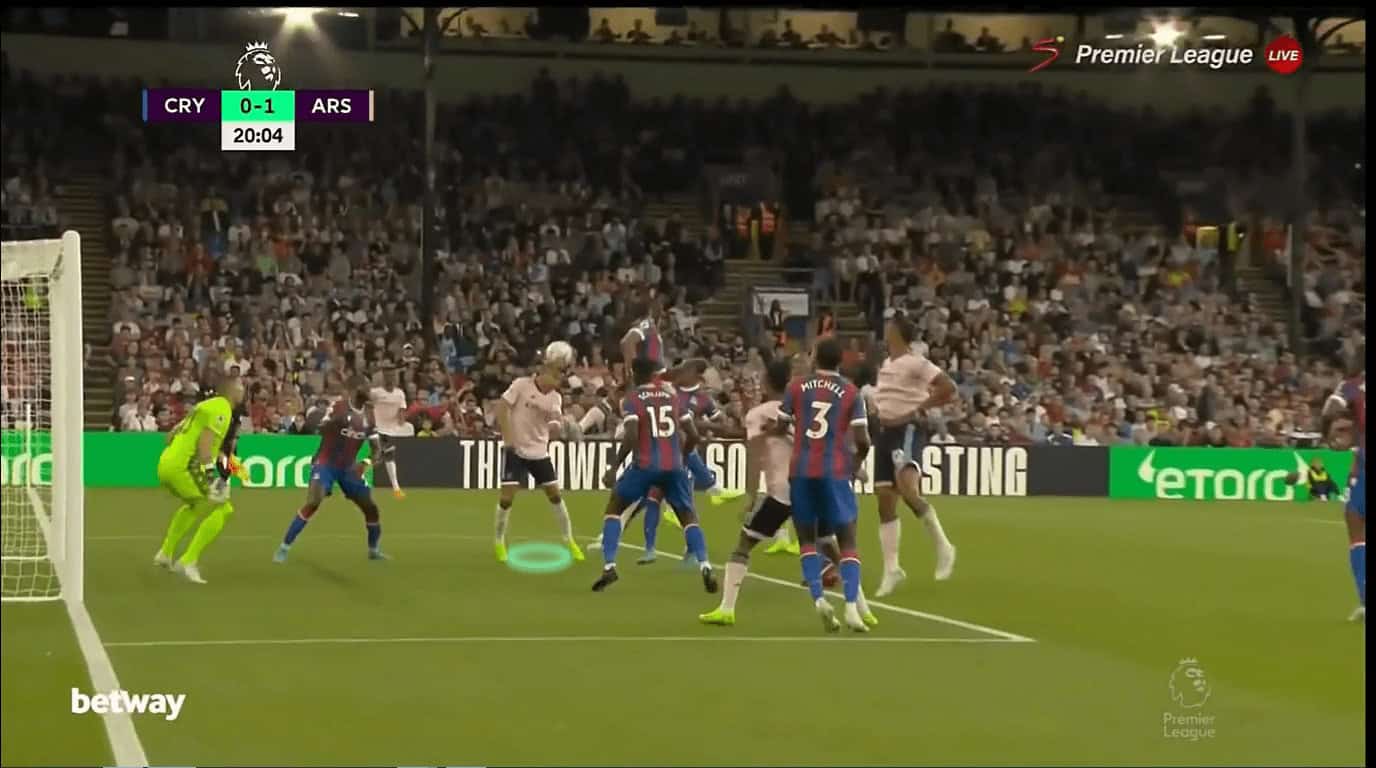
Here, Newcastle pulled off a brilliant corner routine versus The Eagles, but there is something different on display. Crystal Palace defend with two zonal markers highlighted in green, one player in the rebound zone (out of shot) and the remaining seven as man-markers. Newcastle’s trick was the absence of a short corner option and attacking with seven players in the box, so there is a two-versus-one situation for Newcastle in the rebound zone.
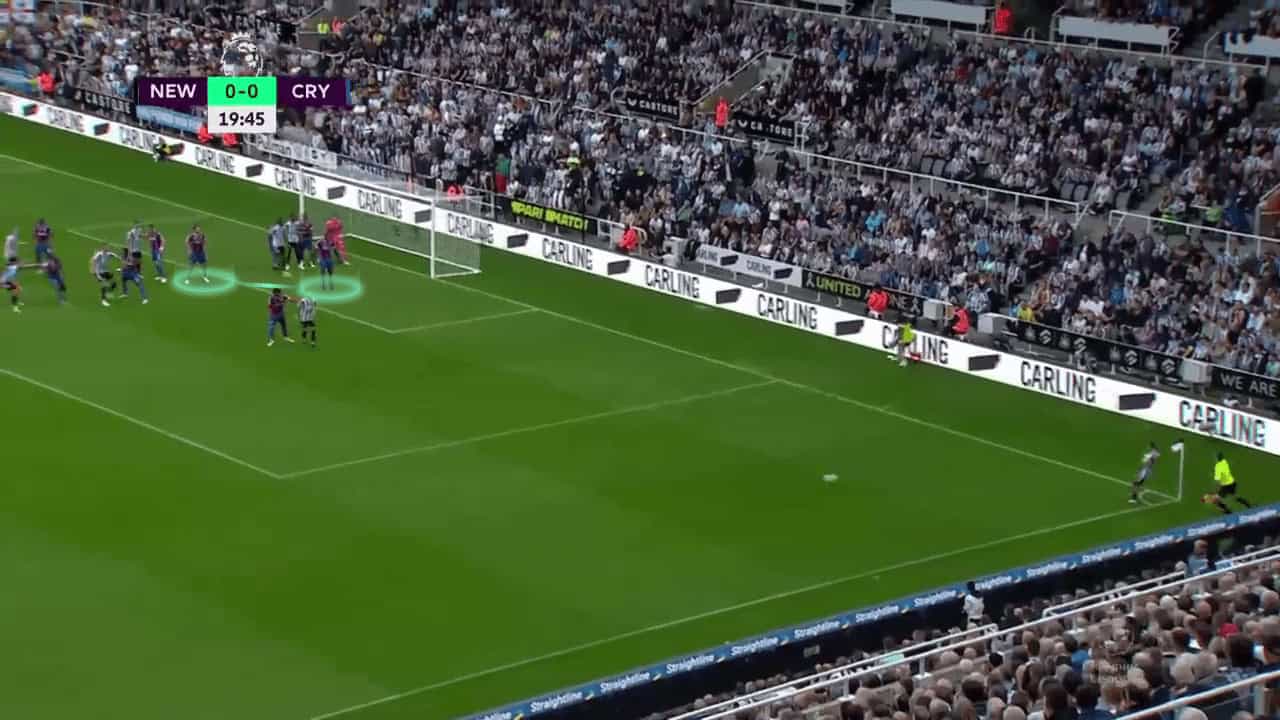
As shown below, there isn’t a short option near the taker to receive a pass, but the taker passes it directly to the rebound zone. Then, the routine begins. The first thing to know is that the targeted zone is on the far post, so the player with the yellow arrow goes to block the zonal player, preventing him from going back.
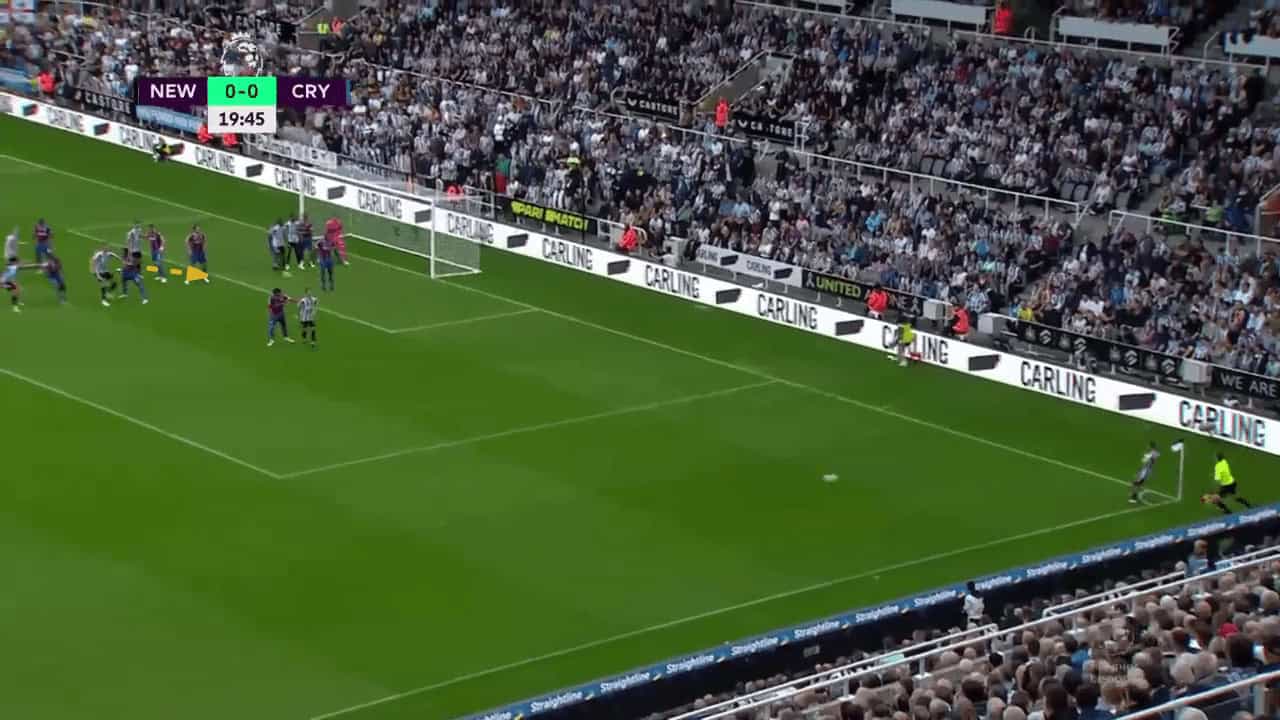
The target man in the yellow arrow is the second player in the rebound zone who starts moving when the taker passes the ball to the first player in the rebound zone. This routine shocks Crystal Palace’s players, but the green highlighted blocks are important to prevent any player from going to the far post.
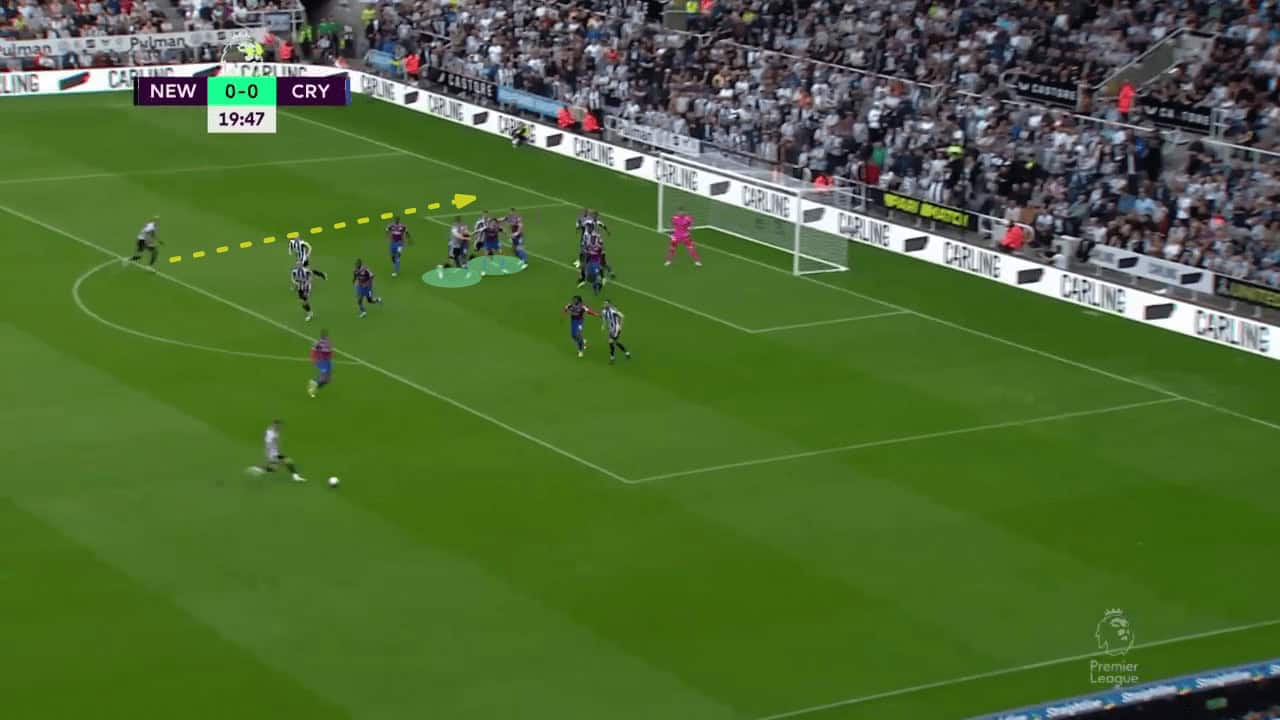
Joelinton strikes the ball wide for a goal kick with two players, highlighted in green, framing the goal.
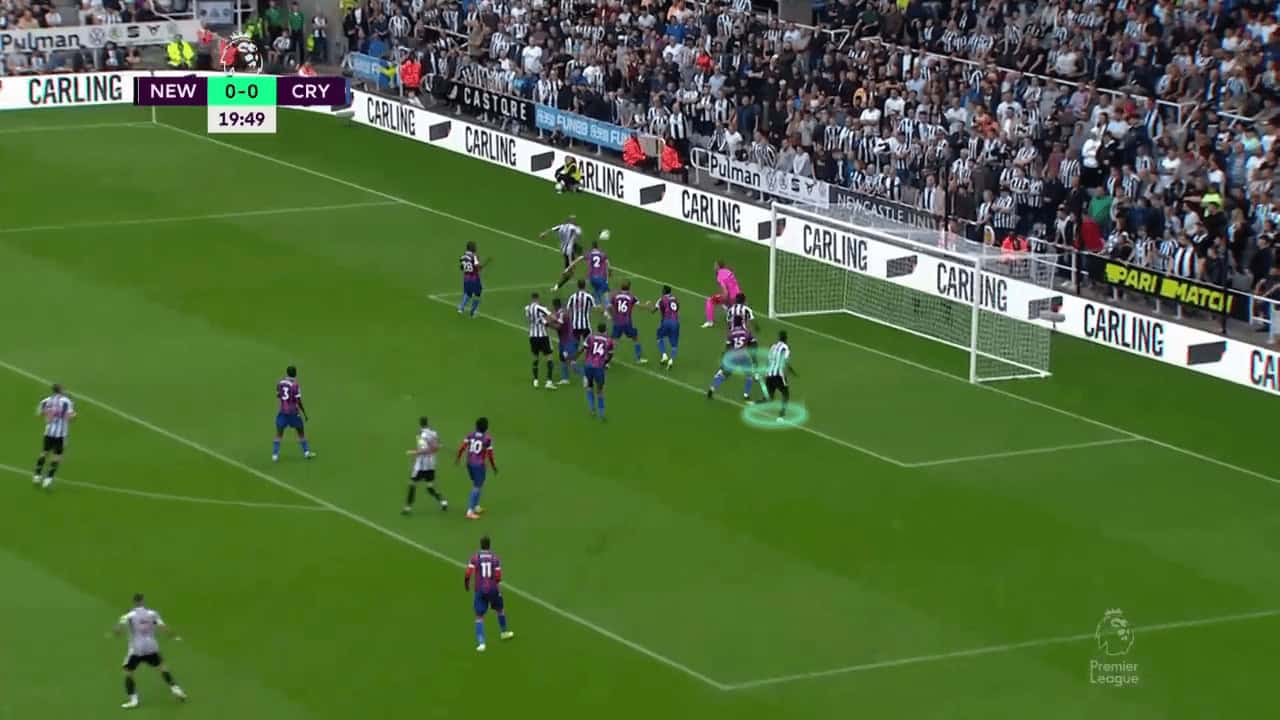
Positional superiority by using flicks
Here in this next example, Newcastle defend with two zonal markers (highlighted in green), Miguel Almiron is there to defend the short corner if it happens while Joe Willock defends the rebound zone. The remaining six players act as man-markers.
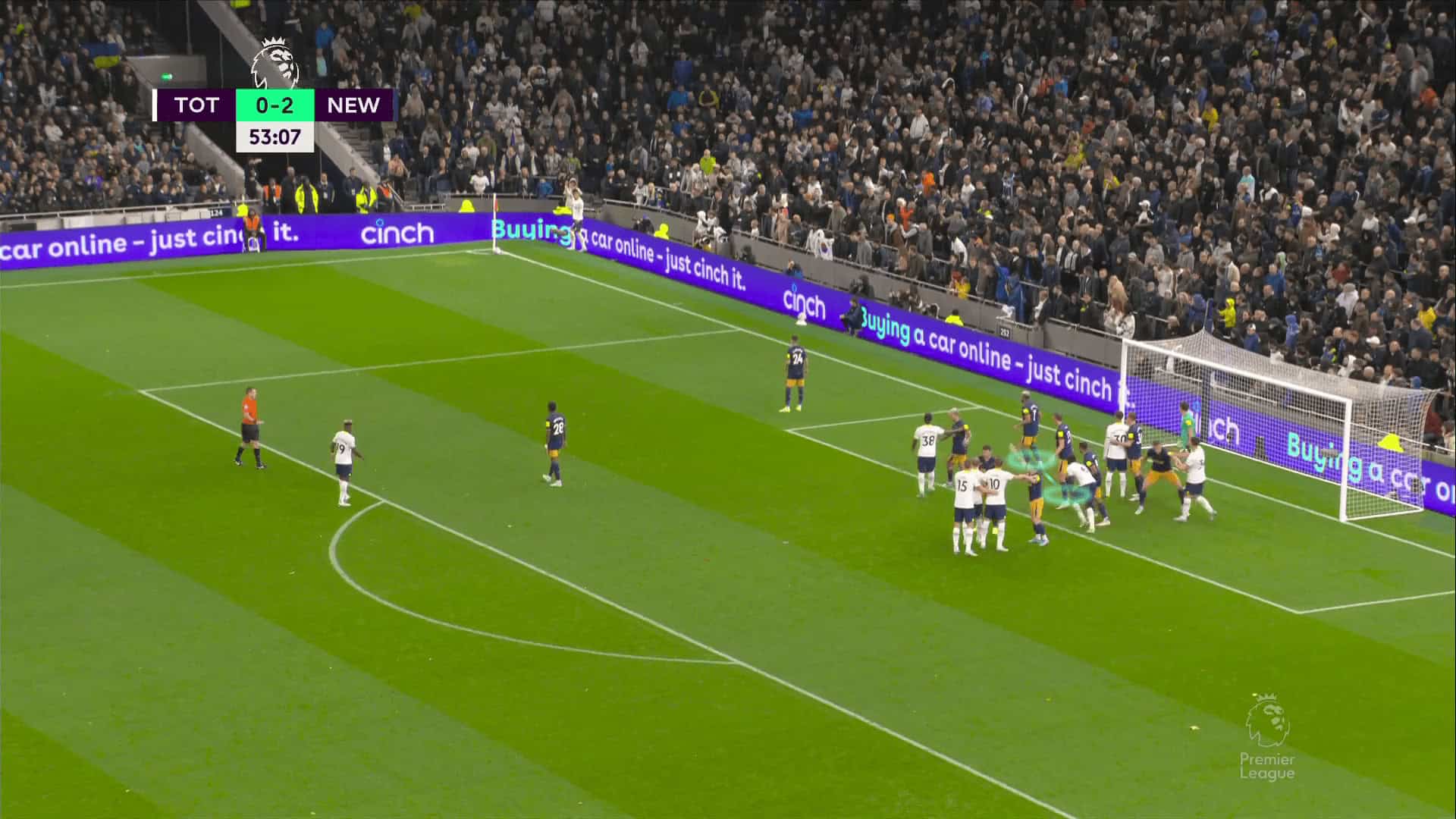
Clement Lenglet, with the green arrow, is the player who flicks the ball in this routine, so as the taker prepares to play, he starts moving in a curved run around the goalkeeper, using him as a screen to win a moment before his marker comes from Joelinton’s blind side. You can notice that there are seven players of Tottenham against six markers, so Eric Dier with a yellow arrow runs towards the near post to hit the ball if the ball passed Lenglet using Oliver Skipp as a screen.
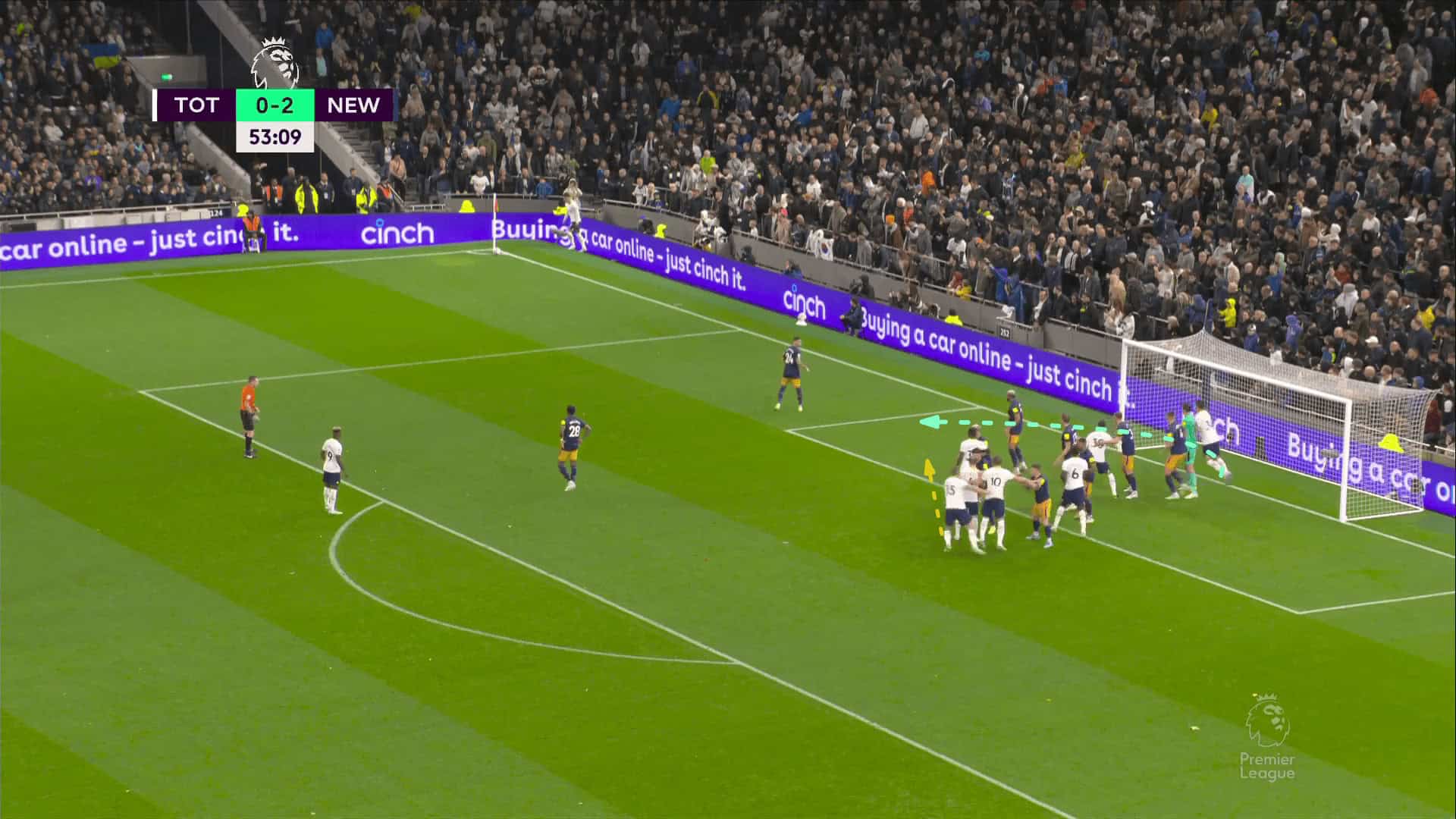
To make sure that Lenglet can get the ball, Spurs need to block the two zonal markers we have mentioned, so when the taker prepares to move, Rodrigo Bentancur goes to block Joelinton (the yellow arrow) and Davinson Sanchez blocks Burn (the green arrow).
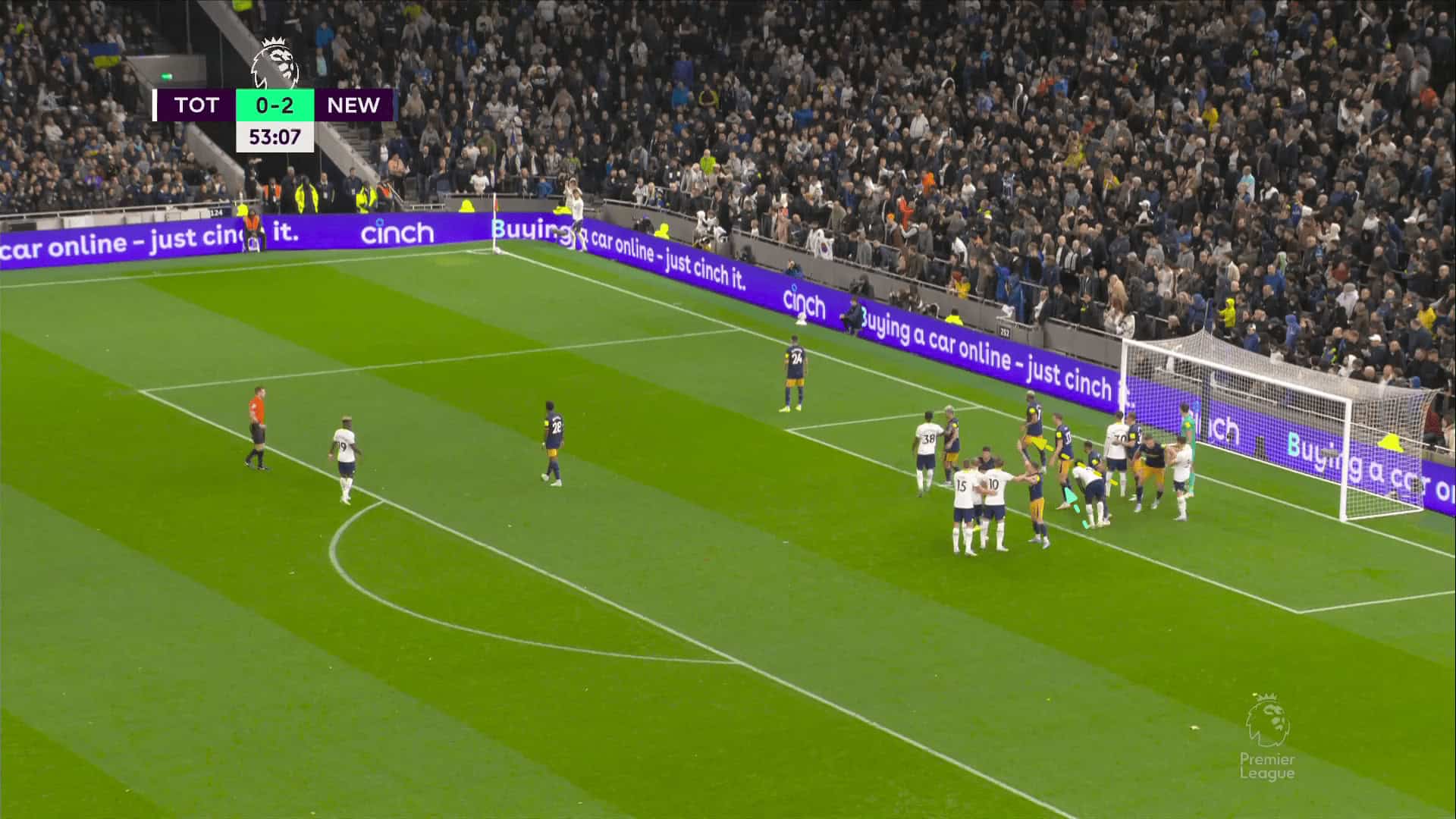
Here, the two blocks we have mentioned happen in green, Skipp, with a yellow arrow, returned back to the rebound zone after having previously been performing the screen and Yves Bissouma, with a red arrow, dragged his marker back to empty the area in front of the far post for Harry Kane.
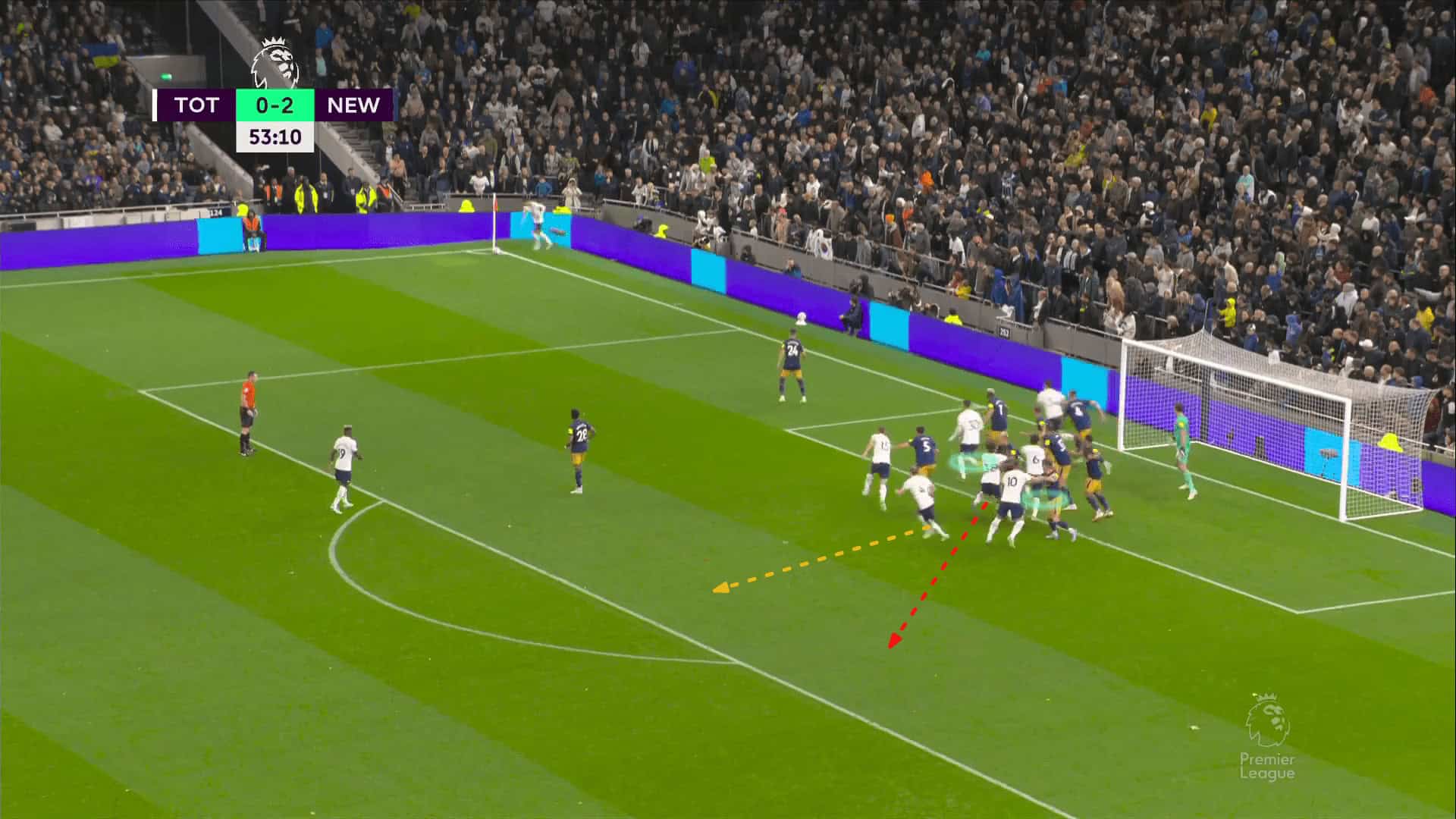
Here, we can see the two blocks we have mentioned happen in green. Skipp, with a yellow arrow, returned back to the rebound zone after doing the screen and Bissouma, with a red arrow, dragged his marker back to empty the area in front of the far post for Kane.
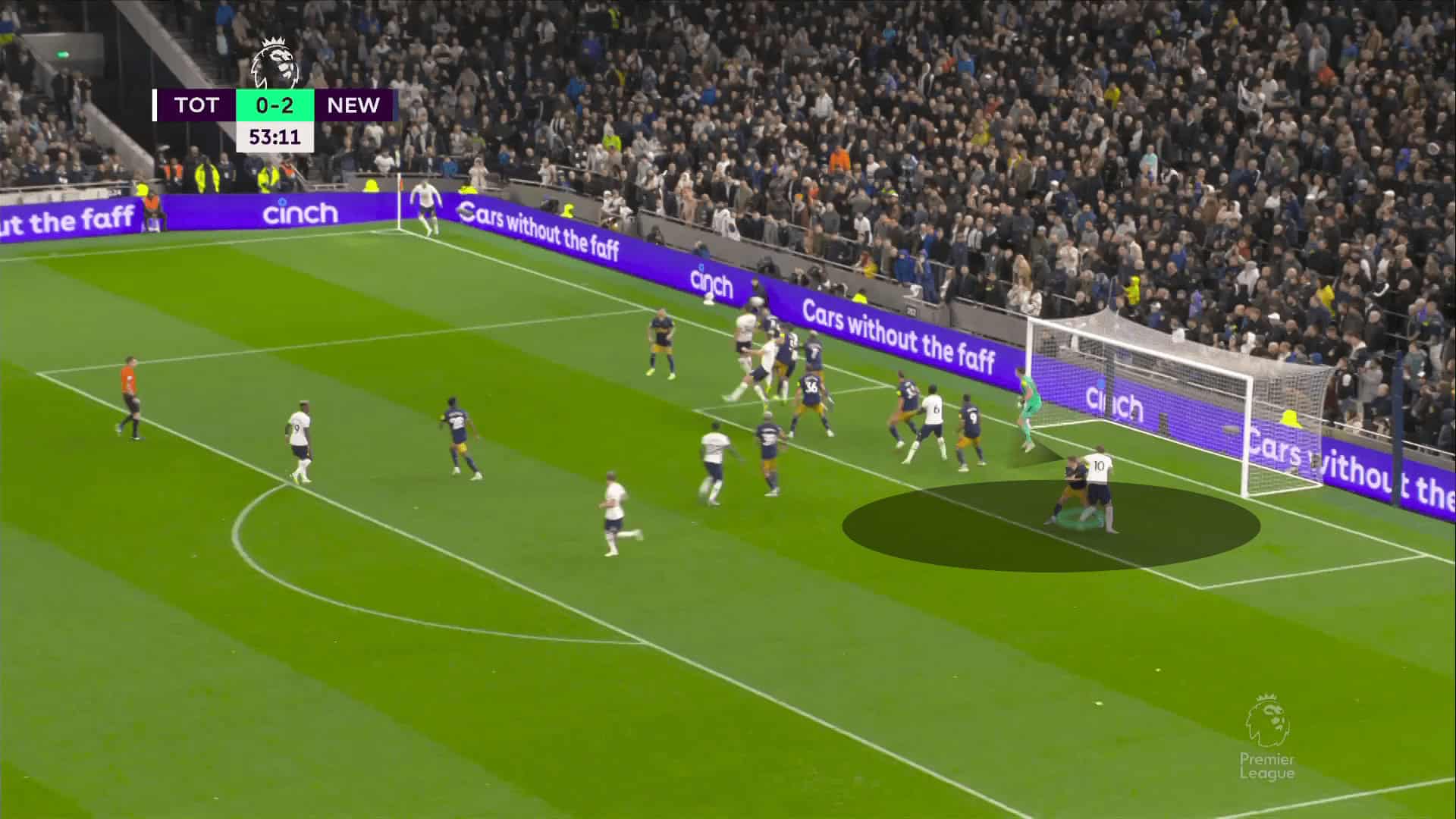
Here, Kieran Tripper turns towards Harry Kane, losing connection with the ball. The second principle applied here is “mismatch” because if you put Kane in a 1v1 situation, he will have superiority.
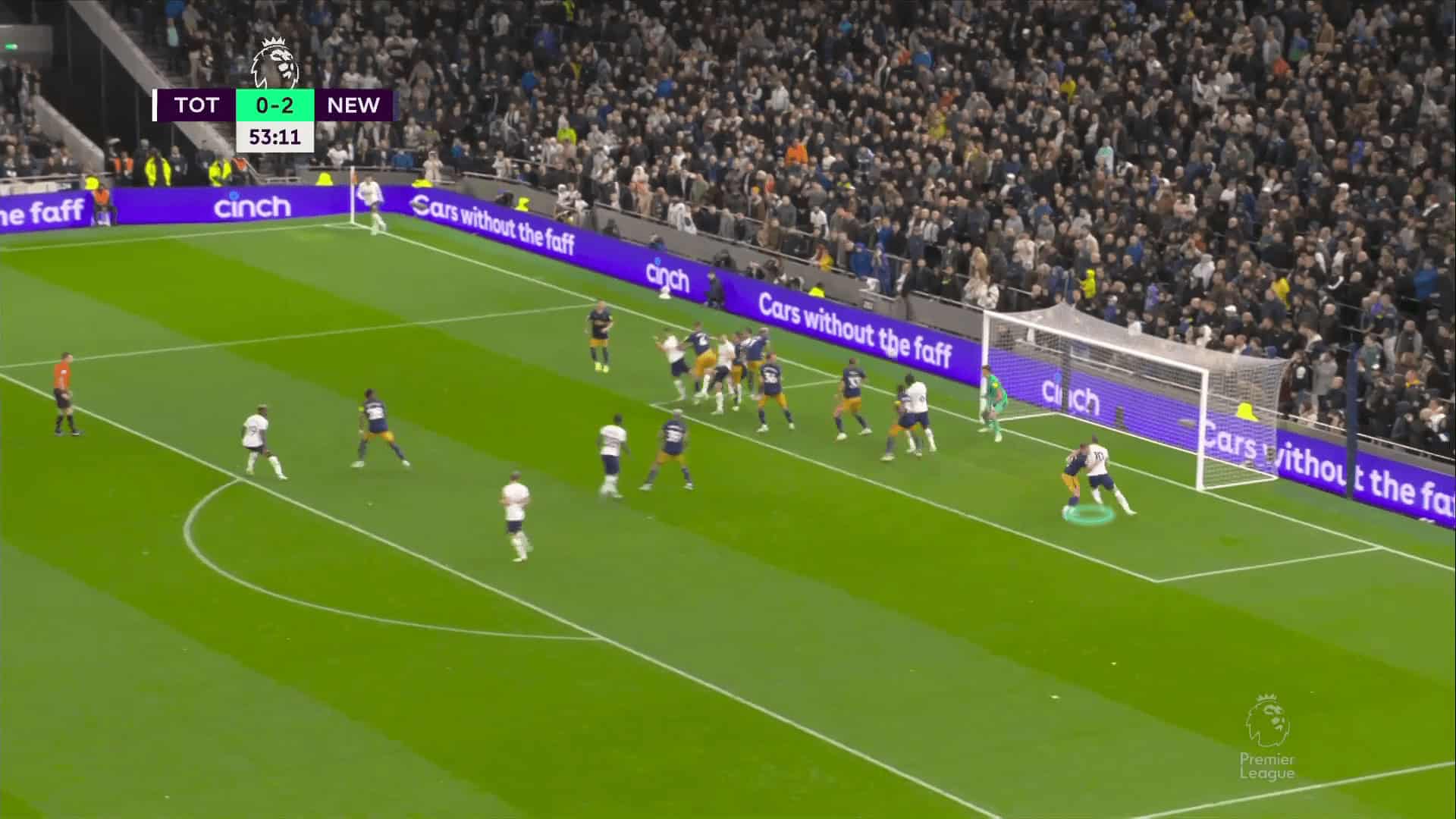
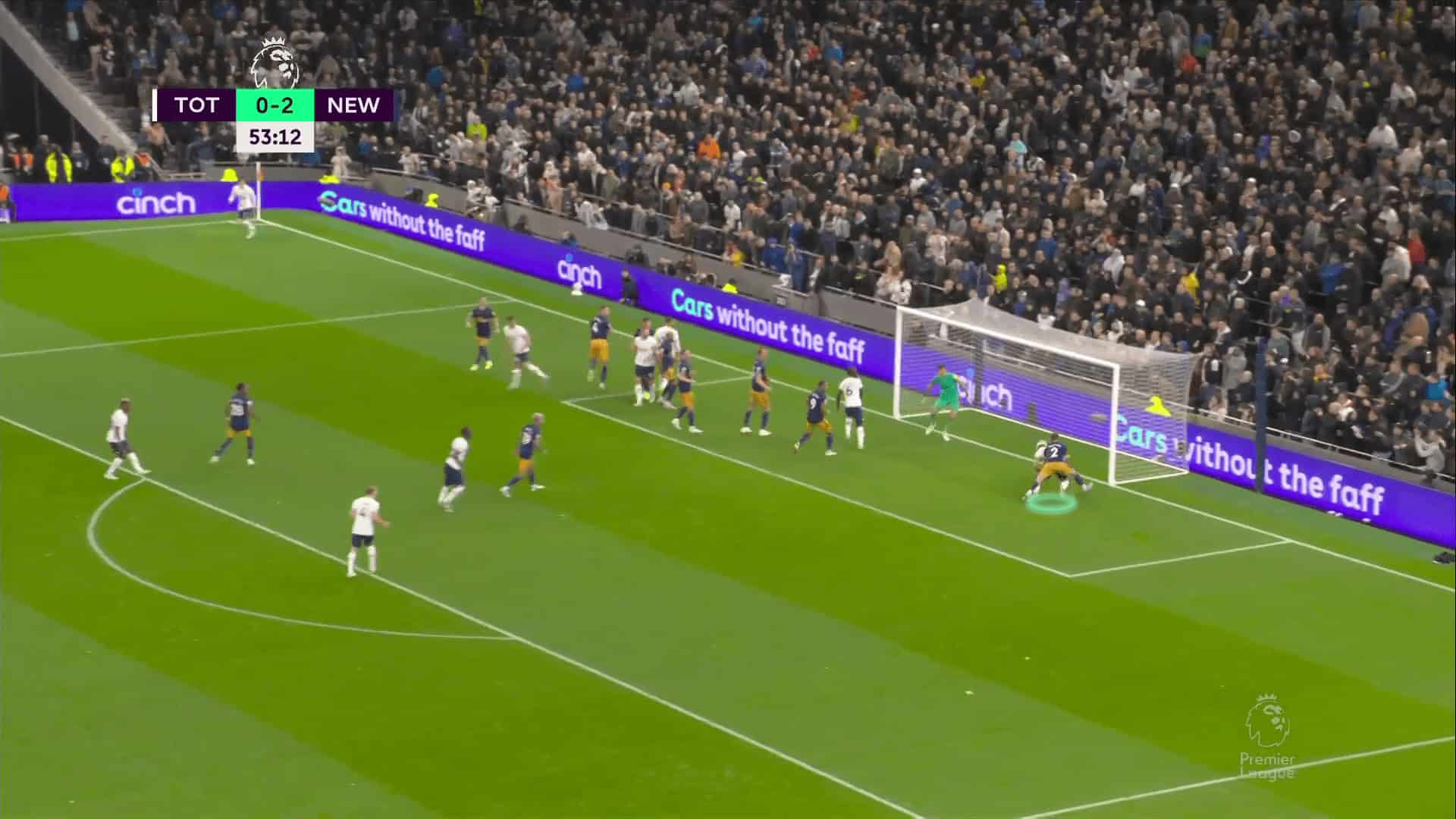
Nottingham Forest’s defensive scheme is shown below. With two zonal markers (in green), one of them helps the player on the edge of the box (in yellow) to defend the short corner, while another player (in black) stands in the rebound zone. They’ve got five man-markers and a player positioned just behind, anticipating the counterattack.
Saka moves acting like he will receive a short pass dragging one of the two zonal players who stepped a little forward to prevent a 1v2 situation, so the flick area is less protected.
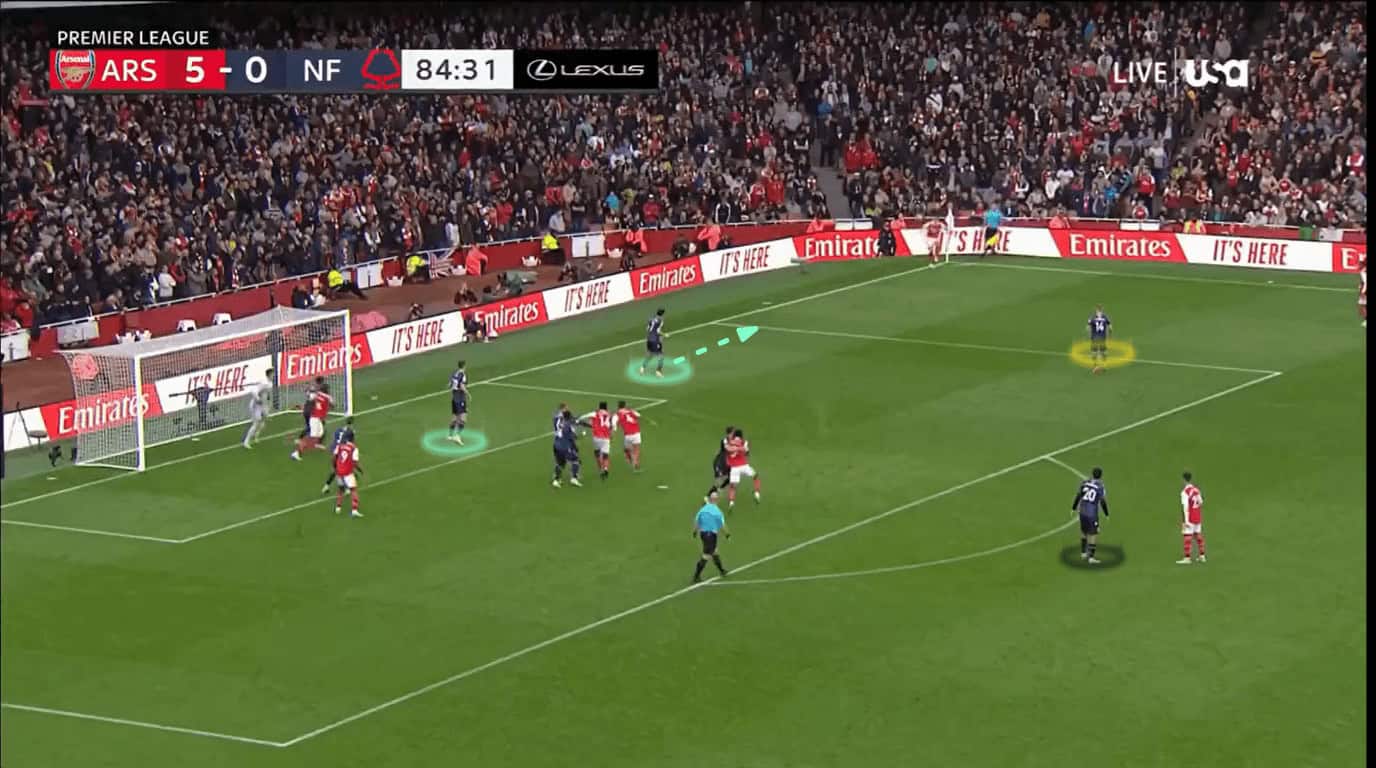
Ben White moves towards this space, using Nketiah (highlighted in green) as a screen to escape from his man-marker.
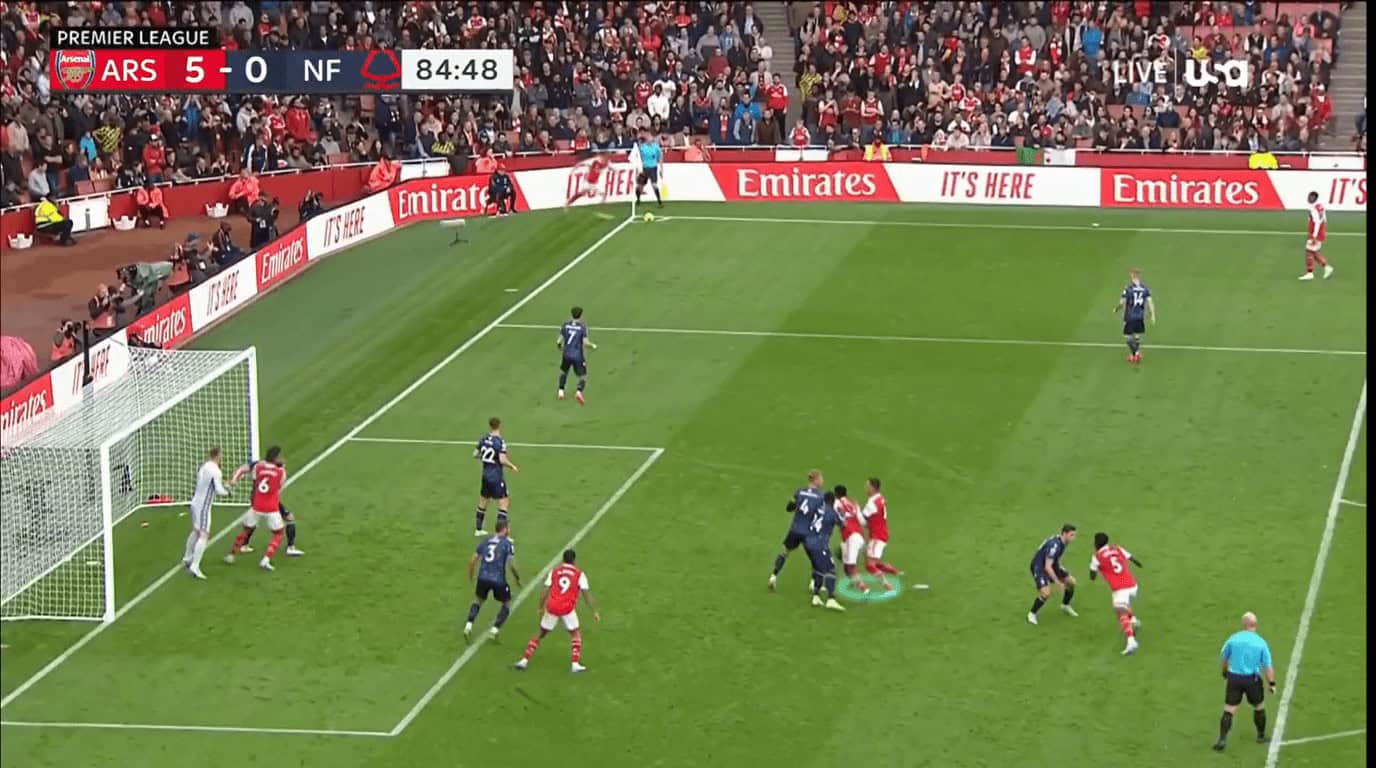
Jesus (highlighted in green) uses the principle of orientation that we have mentioned. He started at the defender’s blind side, then moves after White’s flick, but misses the ball.
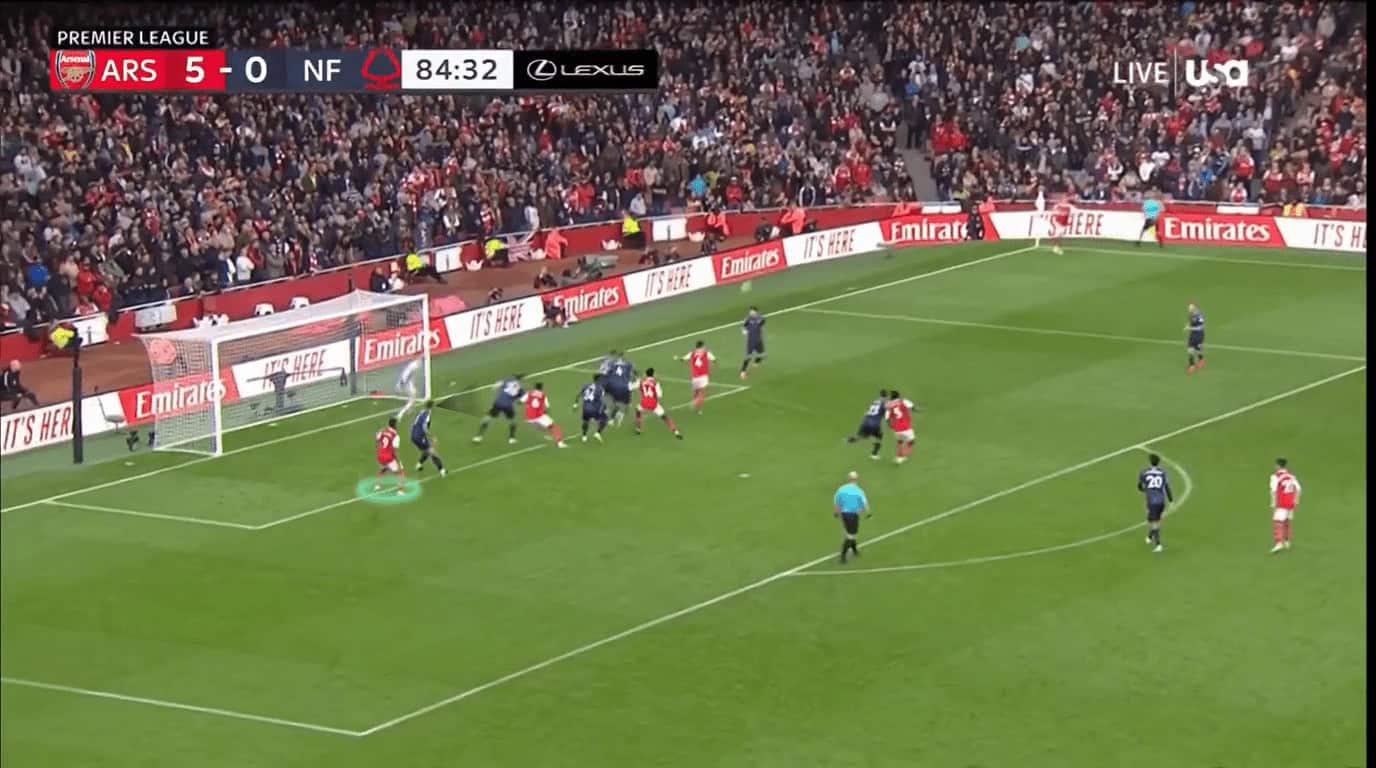
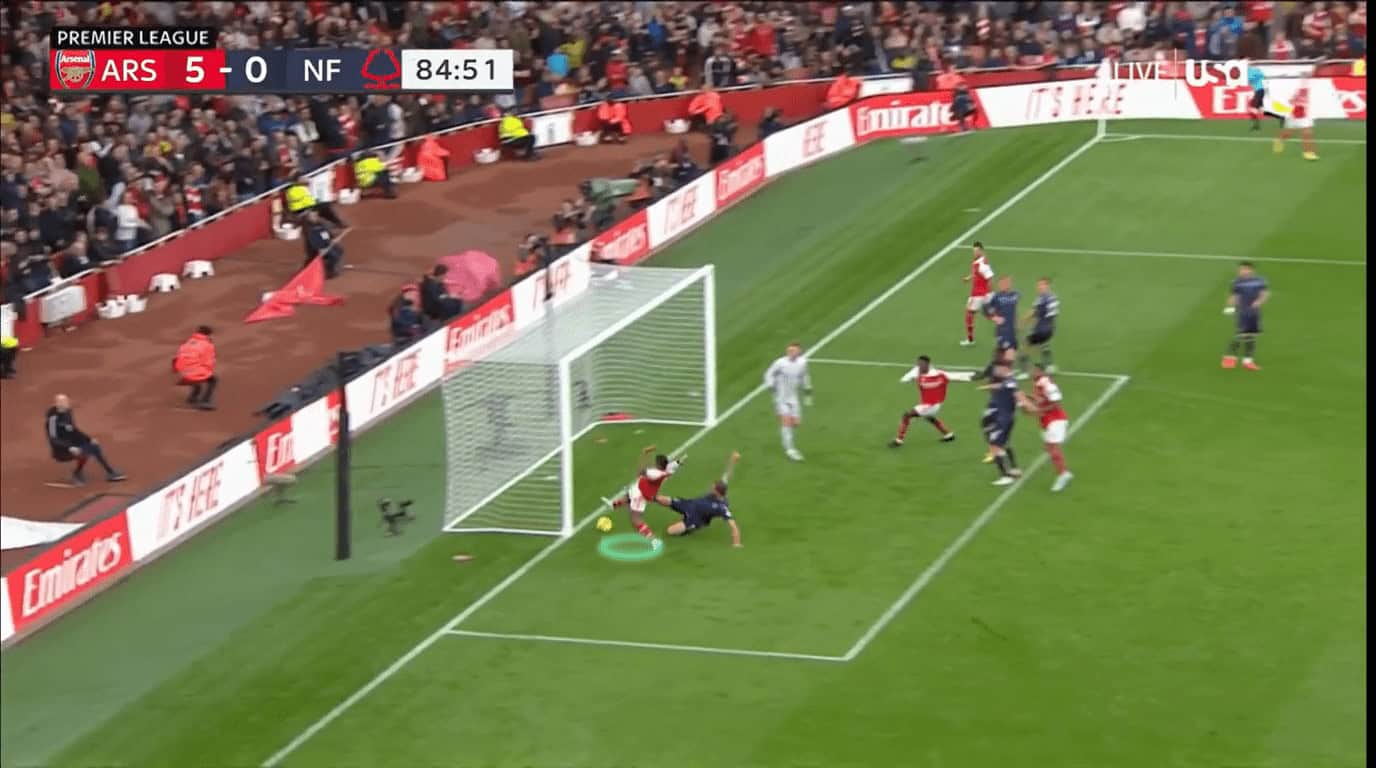
Conclusion
This analysis has explained the disadvantages of the man-marking defending system and how the opponents could exploit this by using several principles to design their routines. With that said, routines change from one opponent to another depending on many things we have mentioned like their abilities in aerial duels, their initial positions and how they defend the rebound area.
Every system has disadvantages that opponents try to exploit, so choosing the defending system of corners depends on the personal opinion of the coach or the set-piece analyst, but this is half the story. Coaches may prefer a system, but it is not suitable for their players, so you can clearly notice that there is not a ‘100% always correct’ aspect in football.






Comments